This review was provided for free using a demo bike from Roadrunner Bike Center provided by Specialized. My goal is to be transparent and unbiased with you, this video and writeup are not meant to be an endorsement of Specialized products. I welcome your corrections, additions, and feedback in the comments below, and the Specialized electric bike forums.
Observations:
- The Turbo Tero X series is my personal favorite from Specialized right now, because the bikes are capable in town and off road! The price point is pretty decent for the 4.0 at $4,500 given the premium drive systems, frame sizes, and dealer network. I tested the 6.0 model here, all Tero X models are Class 3 speed pedelec capable of 28mph top speed.
- Beautiful integrated battery pack that isn’t too long, which can compromise frame design and sizing, and doesn’t have sharp edges. The pack mounts from below the downtube and locks with an AXA locking core and long key that is easy to use. There is no plastic shield that doesn’t lock to the frame and could fall off… it’s just clean, simple, and sturdy. When mounted, the pack doesn’t rattle, is highly water resistant with IPX6 rating, and uses the Rosenberger EnergyBus magnetic interface that is less likely to break or pull the bike over if the wire gets snagged. Excellent.
- The Tero X comes in three trim levels with 6.0 offering the highest end components, highest torque motor, and highest top speed of 28mph in the United States. For $1,000 less, you can get the 5.0 which still has the high capacity battery, but lower torque 70nm motor vs. 90nm. The entry point 4.0 model has the smallest 530 watt hour battery, and the lowest torque 50nm power. All trim levels appear to come in four sizes, two colors, and are high-step only.
- It’s important to register the bike with the Specialized Mission Control smartphone app to unlock the lifetime warranty on the frame and enhanced support as well as locking ability. The app can be used to unlock the bike or set a numeric pin that can unlock the bike using the TCD2 LCD display that’s mounted to the handlebar. Most shops should help you get this all setup when you purchase and pick up the bike, unless you’re getting a click to collect at a non-specialized shop.
- The Tero X does a lot right, in my opinion, and is one of the best ebikes for 2023 because of the thoughtful custom fenders, rear rack, display panel, the overall look and feel, and variety of trim levels and sizes. I love full suspension ebikes, because I tend to ride farther and at higher average speeds on an electric bicycle vs. acoustic. This is even more relevant for Class 3 products like the Tero X 5.0 and 6.0. I also admire the quality and depth of the Specialized Mission Control smartphone app. Availability might be limited in the size and color you want as Specialized appears to sell out of products each year.
Pros:
- The bike looks great and is above average in most ways… It’s one of the best ebikes I’ve tested. It rides solid and quiet, the grips and saddle feel very good to me, and I appreciate the attention to detail with internally routed cables, reflective stickers (including the large Specialized logo on the downtube), long rubberized slap guard on the chain stay, the scuff guard stickers on the crank arms, the double bottle cage bosses, the direct mount eyelets on the suspension lowers, the fact that it comes in two colors, four sizes, and three trim levels.
- Four frame sizes allow for better fit, the bike can accommodate a wider range of riders. While it does not come in mid-step or step-thru, that is not uncommon for full suspension mountain bikes, and the dropper seat post makes mounting easier. This part is great off-road use where you might stand up and use your bent legs to navigate technical descents, or have to jump forward and stabilize the bike.
- I love the sturdy tubular alloy fenders with Drytech water routing and Flextender up front. There are even channels in the front fender that is designed to route water out the sides vs. forward and up… which can get into your face. The rear rack is capable of hauling two panniers totaling 20kg (44lbs) and they’ve included slide blockers and bungee loops so your bags will be more secure.
- Extremely bright integrated headlight that goes from 600 lumens to 1,000 lumens when you press the high-beam button near the left grip. This thing will light the path quite well, and has little side cutouts to help you be visible from more angles (though I feel they could be a little longer). The rear light is very unique, having a deceleration detection feature that doubles brightness form two LEDs to four LEDs (11 lumens to 22 lumens). Some other ebikes use motor inhibitors to activate the rear light, but that requires special brake levers that aren’t usually as nice or adjustable as the ones used here (which have tool free reach and throw adjustment). I also like that they included a decent bell.
- Excellent placement for the headlight, it’s way up high and fully suspended vs. being mounted to the arch of the suspension fork where it could vibrate more and get partially blocked by the front fender. It points where you steer in this position as well.
- The display panel, button pad, and smartphone app are some of the best I’ve seen. While there is some room for further improvement, I love that it shows battery percentage, has a built-in alarm (although it doesn’t alert you, just makes noise if the bike is shaken and won’t power up without the pin), provides walk assist (hold the + button), allows you to turn off the lights (hold the F1 button), and further refine the three levels of assist with micro tune (10% steps for each of the assist levels by pressing F2). I do wish that you could dim the display and turn off the beeps and haptic buzz within the display settings vs. having to use the smartphone app. I love that you can customize screens on the display, plan trips to ensure you don’t run the battery dry, maintain a set heart rate, and so much more with the Mission Control smartphone app.
- Built into the right side of the TCD2 MasterMind display panel is a USB-C charging port that offers 5 volts and a full amp of power output to maintain a smartphone or other portable electronic device! Way to go Specialized, this is very relevant given the fancy smartphone app with mapping and heart rate monitor compatibility etc. The app even connects with Strava and Kamoot so Being able to leverage that large 710 watt hour battery is exactly the right decision in my opinion!
- The bike has a very high ingress protection rating of IPX6 which is meant to resist high-pressure, heavy sprays of water and deter dust and mud. This makes perfect sense given the attention paid to fender design.
- The bike is very trail capable with two air shocks and a blend of cross country and trail geometry. The mullet setup surprised me, having a 29er front wheel and 27.5″ rear wheel. This provides a lower attack angle but keeps the rear portion nimble and quick. Of course, the bike makes for an excellent SUV or commuter in the city, and that suspension setup adds a lot of comfort for higher speed Class 3 riding up to 28mph.
- RockShox suspension front and rear with black anodized stanchions that look beautiful. Both offer rebound adjust, the front has a compression clicker, and the rear has lockout which would reduce bob for packed trails or paved streets. The rear swing arm is single pivot, which isn’t as fancy in some ways, but probably enables the rear rack and fender setup.
- Extra sturdy hubs and axles, both are Boost (wider for improved spoke bracing angle) and use thru-axles vs. narrower 9mm skewers. It’s truly trail capable vs. cheaper bikes that have knobby tires but aren’t as sturdy.
- Great design choice including a dropper seat post here, which has infinite adjust vs. fixed steps. It makes the bike more approachable and is a feature that works just as well in the city as it does on the trails. The base diameter is 34.9mm if you wish to swap it for something else.
- The motor is fairly compact with a more standard width (q-factor), so the cranks aren’t pushed out wide. I appreciate that it only weighs 6.39lbs because of the magnesium housing, and that it’s so smooth. Brose uses a Gates carbon belt drive inside vs. all plastic gears like many of the competitors. I think it’s neat that the aluminum alloy frame actually surrounds the motor and protects the base because it’s sleeker, doesn’t hang down as far, and is probably lighter than the extra shields used to protect competing mid-drives.
- The motor controller measures rear wheel speed with a sensor and magnet that are well protected (mounted to the chain stay and magnet bolted to the left side of the rear wheel hub). The design is more durable than a spoke mounted magnet. So the controller measures rear wheel speed, pedal cadence, and pedal torque to deliver a very natural and dynamic ride feel. Combined with the settings in the Mission control app and Micro Tune right on the LCD panel, it can do exactly what you want and feel more connected to your pedaling.
- If you prefer to pedal quickly or just happen to shift down to a low gear for a climb, the motor can keep up. It’s rated to 120+ RPM so you won’t have to lose speed and downshift again like some of the older motors.
- The battery design is way above average, in my opinion. The pack is very compact for the high capacity it offers, and does not have sharp edges. Since the battery doesn’t require a shield or anything, just has a black metal bottom, it’s probably cheaper to buy replacements and easier to loan or rent a spare. I could imagine stowing one in a pannier or backpack for extended rides.
- The battery charger is excellent too. It’s compact but offers faster 4 amp output for a full charge in roughly four hours. The magnetic interface is an industry standard that won’t get damaged as easily. The plug interface is the same whether charging the pack on or off the bike, so they didn’t waste materials or require a dongle adapter like some competing brands. I feel that they did everything right here.
- There’s a nice little magnetic plastic cover that protects the battery charge port while riding the bike, and the release mechanism that interacts with the locking core seems to protect the battery port and locking core. This area of the bike seems tough and well thought out… even if it is low down on the left side vs. high up on the right as I’d prefer for easier interaction. Do be careful with the magnetic plastic cover for the charge port, as I’ve seen them get pulled off before.
- Excellent drivetrain with an extremely wide range of gears, 10 to 50 tooth 500%! The SRAM cassette, derailleur, and shifters are easy to use and I trust the brand. The 38 tooth chainring is made from ebike specific carbon steel and has a narrow-wide tooth pattern to reduce the possibility of drops, and a plastic guide adds even more protection. I believe the bottom bracket spindle is hollow and probably stiffer and lighter than alternative designs.
- Great brake setup with large Avid rotors (200mm front and 180mm rear). Both brakes use quad piston calipers for even power distribution and larger surface area. The two-finger brake levers offer adjustable reach for different sized hands, adjustable throw to change how quickly the brakes engage, and the larger SRAM Code reservoirs provide a more progressive stop vs. locking up.
- You’ll get 29″ front and 27.5″ rear for M-XL but the Small frame comes with two 27.5″ to match the frame better, and lower the standover height. All of the tires are Specialized specific and worked well during my tests. The wide 2.35″ design provides some stability and float, but is more nimble than plus sized. The tires are 2Bliss ready (so you can run without inner tubes) to reduce weight and support lower pressure for comfort and riding on soft terrain.
- Specialized has a decent network of dealers in North America, but also sells internationally and has introduced “click to collect” where they will ship bikes to local shops for assembly and handoff. They are one of the “big three” largest cycling brands in the world and offer a lifetime warranty on the frame if you register, as well as two year comprehensive support.
- Specialized seems committed to the ebike space as one of the first big players to introduce a bike way back in 2012. They continue to innovate and do things “their way” vs. using third party solutions. So much of this bike, the motor, the battery, the display, the fenders, the racks etc. is all custom and is BETTER THAN most of the competition. I really admire that about Specialized and feel that they move the industry forward.
Cons:
- Weighing in at 58.7lbs (equipped with the metal fenders, rear rack, and lights) this ebike is fairly heavy for cross country or trail riding… but it’s definitely not tipping the scales when you consider the high capacity battery pack. I’m calling out the weight here because Specialized has SL (super light) models that weigh a lot less. Note that the motor and battery weight on all of their ebikes is positioned low and center on the frame, exactly where you’d want it for optimal balance and handling.
- The front fender is extremely long due to the Flextender plastic/rubber piece that provides shoe and shin coverage. It works extremely well, but frequently collides with stairs, curbs, sticks, and other obstacles. Additionally, I noticed more pebbles and sticks would get caught in the knobby tire tread and fly up into the fender, rattling around do to the length and how close the fender is. I see this as more of a trade-off than a con. The fenders can be removed, but I believe the rear pannier rack will also have to be detached in that case.
- The locking core for the battery pack is positioned very low on the left side of the frame. It’s not directly in the path of the left crank arm, but very close. In short, you’ll have to bend down to plug the bike in or unlock the battery, and the key must remain in to re-mount the pack. Thankfully, you can just press and have the battery click into position vs. having a spring loaded key interaction. I personally prefer when the charge port and locking core are positioned high up on the right side of an ebike frame, since that side is easier to access with the bike tipping towards the kickstand.
- The kickstand looks beautiful, and has an adjustable length tip, but is very pointy. For a cross country and trail capable bike, this design has the drawback of sticking into soft terrain easily and allowing the bike to tip over more easily.
- The kickstand may bounce around and add some noise when riding off road. The fenders and rack didn’t rattle, but you could hear gravel bouncing through at times.
- The rear rack may not support trunk bags or child seats because it has a lower weight rating and doesn’t have a platform on top. For some people, this could be a deal killer… but in that case, consider the hardtail Turbo Tero which has a higher weight rating and does have a platform on top!
- The TCD2 MasterMind LCD display is not fully removable, although you can technically use a 2.5mm hex driver to unscrew the mount, then remove a small Allen head screw, and you can also just twist the display if the set screw is not in place (as shown in the video review), but it’s still wired into the bike. This display takes up the space where you might otherwise mount a smartphone or Garmin device, but is required for the electronic lock, alarm, Bluetooth, Ant+ etc. so I see why it’s more permanent. It also does not auto-dim and you need the app to change the brightness vs. having that option in the settings menu which would be more convenient (along with adding beep and haptic vibration on/off there).
- There’s no shift sensing built into the Brose motor controller and this can lead to increased chain and sprocket wear if you don’t back off a bit on your pedaling while shifting, especially with the high torque motors on the 5.0 and 6.0 Tero X models. I believe it’s the reason that Specialized opted for single-shift triggers from SRAM. I did notice some mashing when I wasn’t as intentional about easing off the pedals while shifting, so still be careful.
- Minor considerations here, but the tires do not appear to have puncture resistance or reflective sidewalls. That’s not uncommon on mountain bike tires, which aim to be light and aren’t concerned with reflectivity, but since this is more of an SUV platform, I think these features could add value.
- This is another minor consideration, the handlebars are pretty wide (mountain bike style) and might not fit through doors as easily, or between cars. This is relevant since the bike is setup for city and commuting with the fenders and rear rack. I could see people using the bike in traffic and storing it inside a condo or house. Handlebars are fairly easy and inexpensive to replace if you decide on a more swept-back design or just not so long.

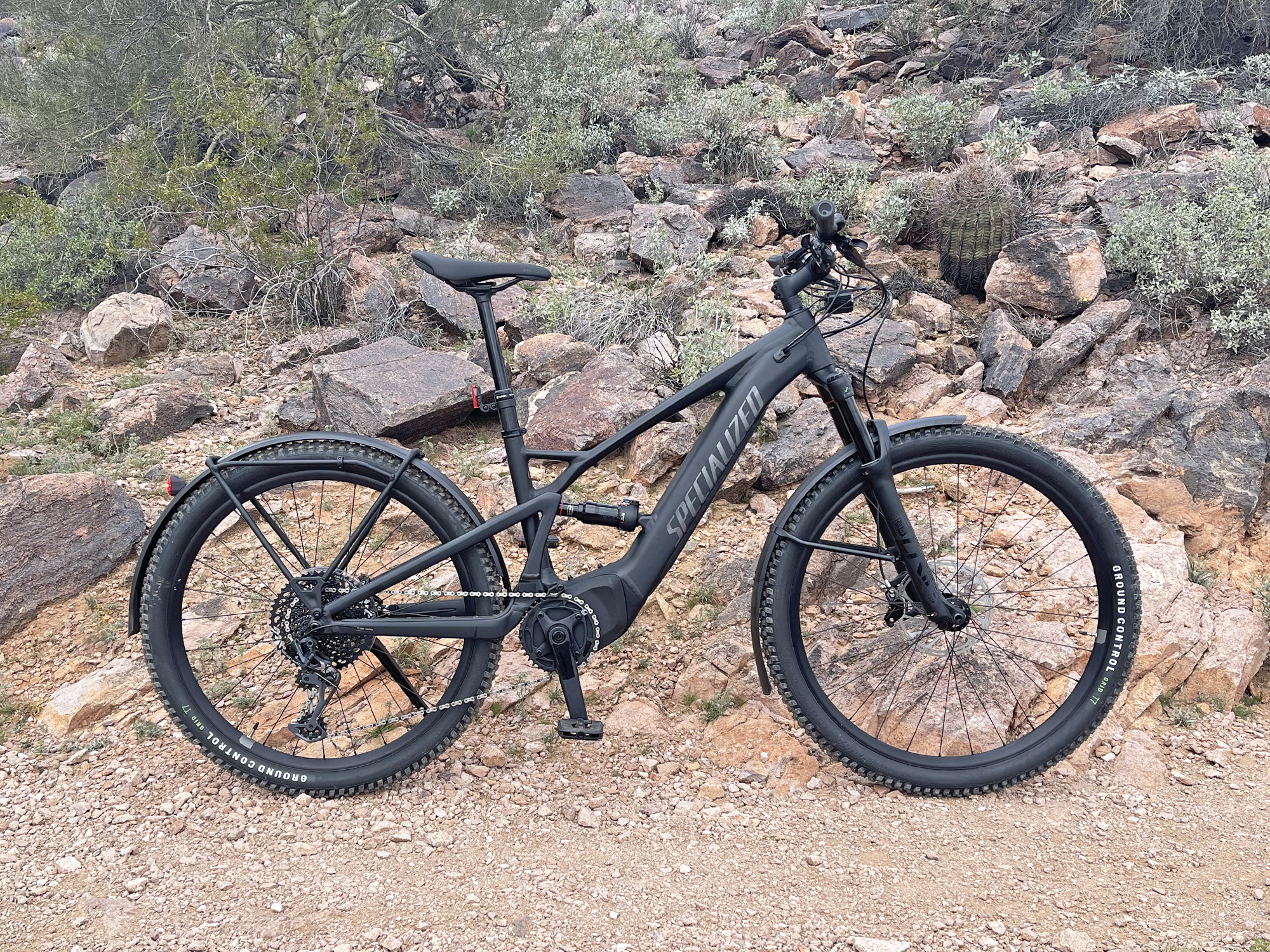

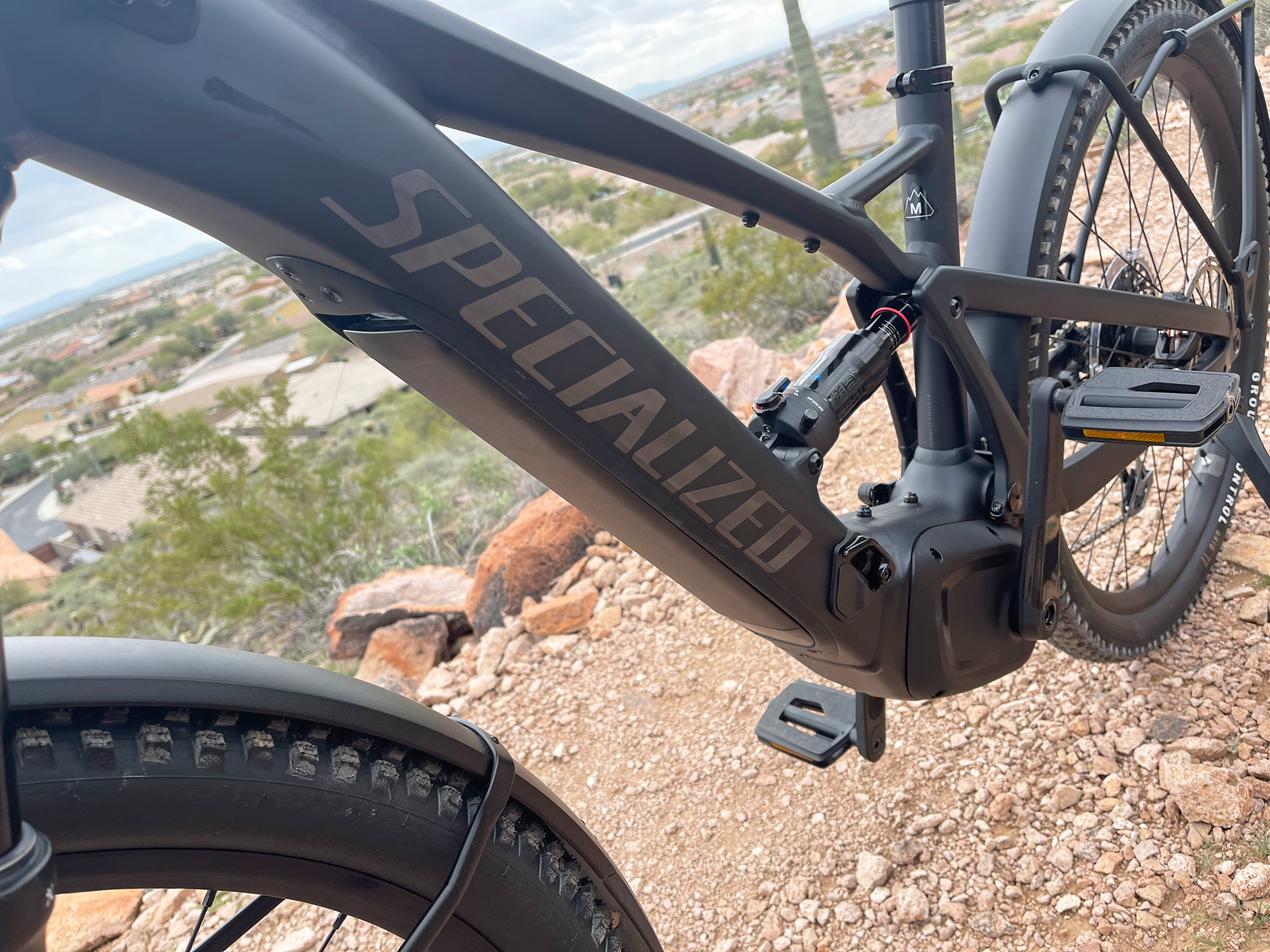

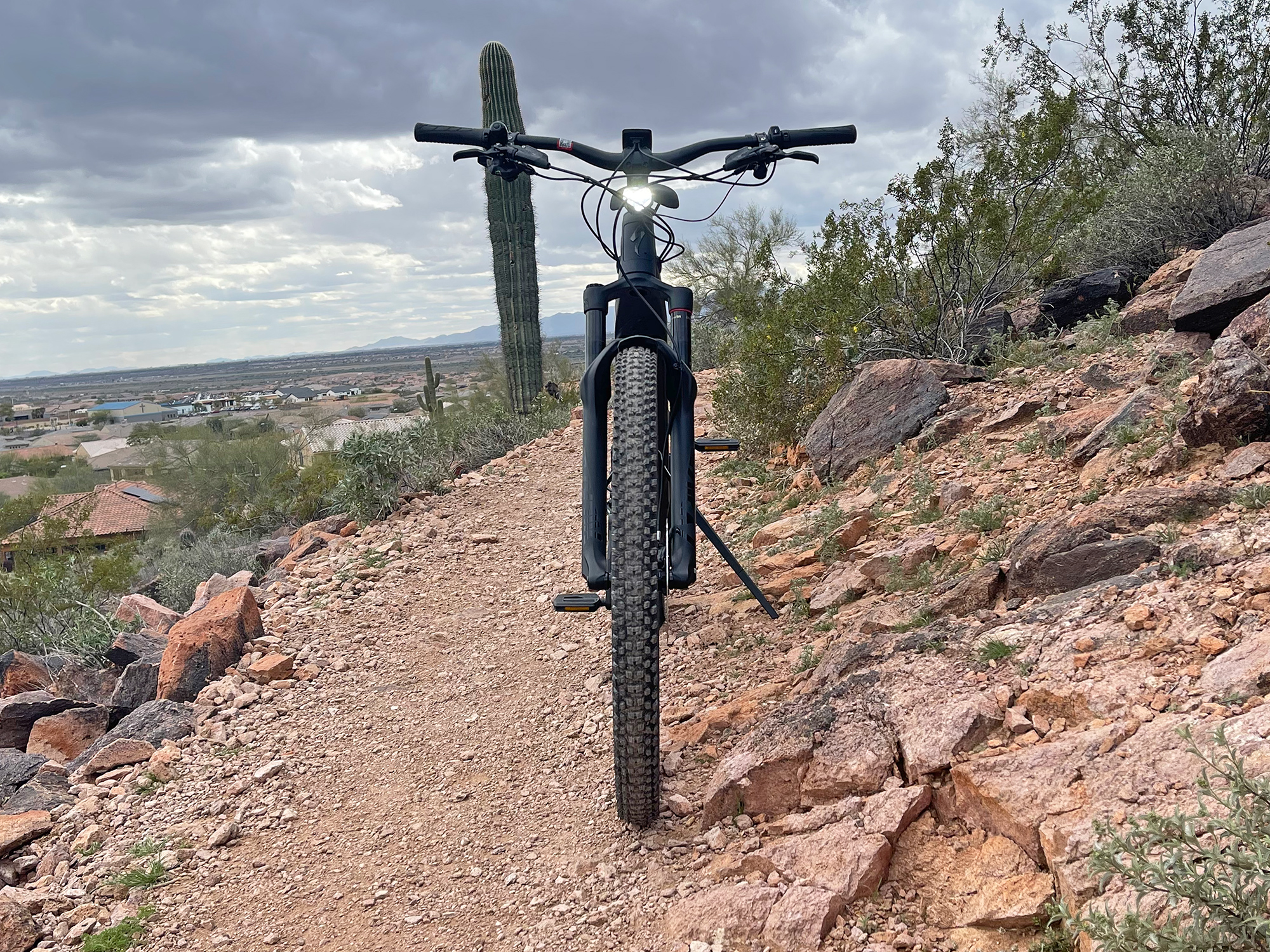
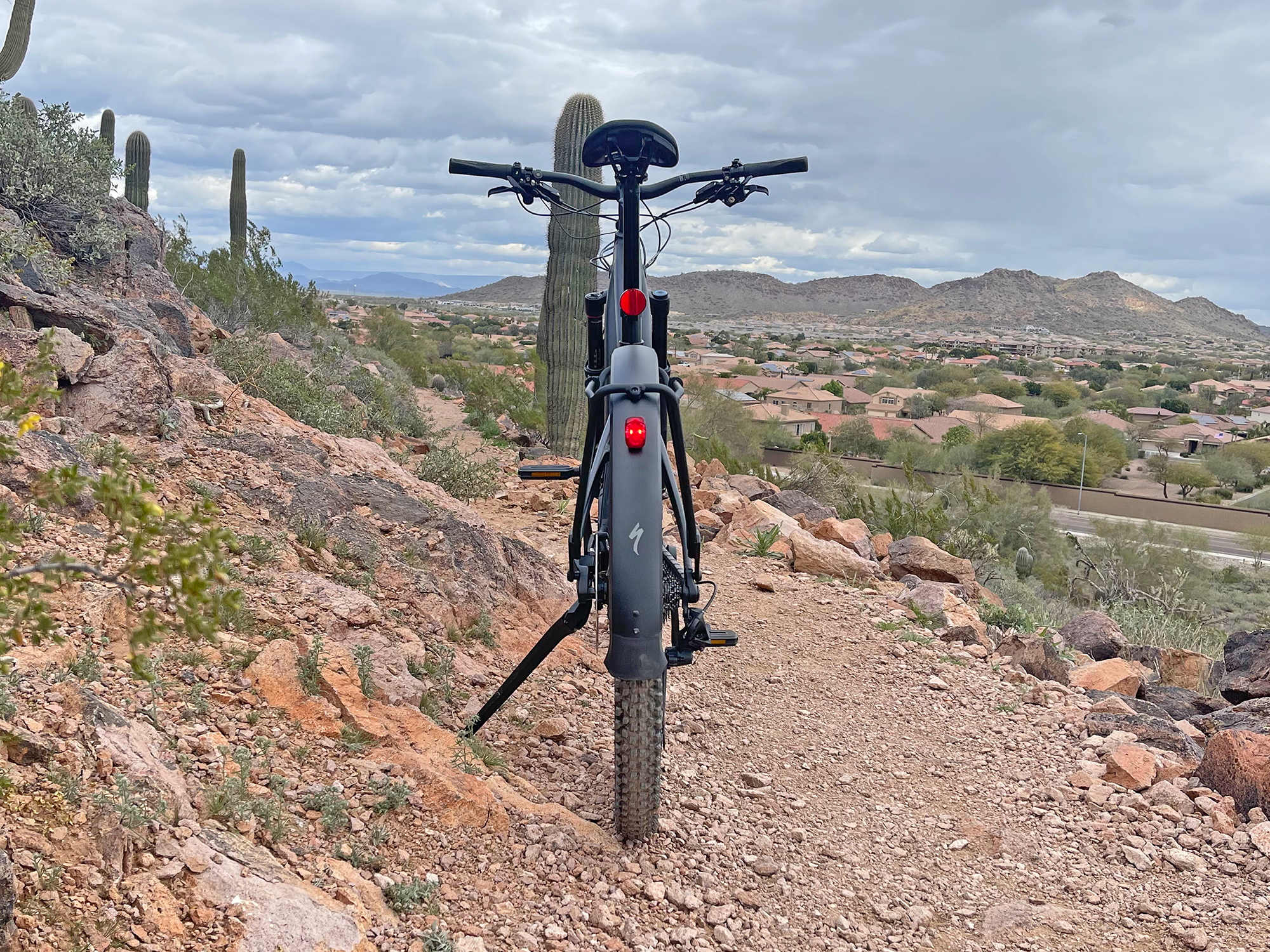
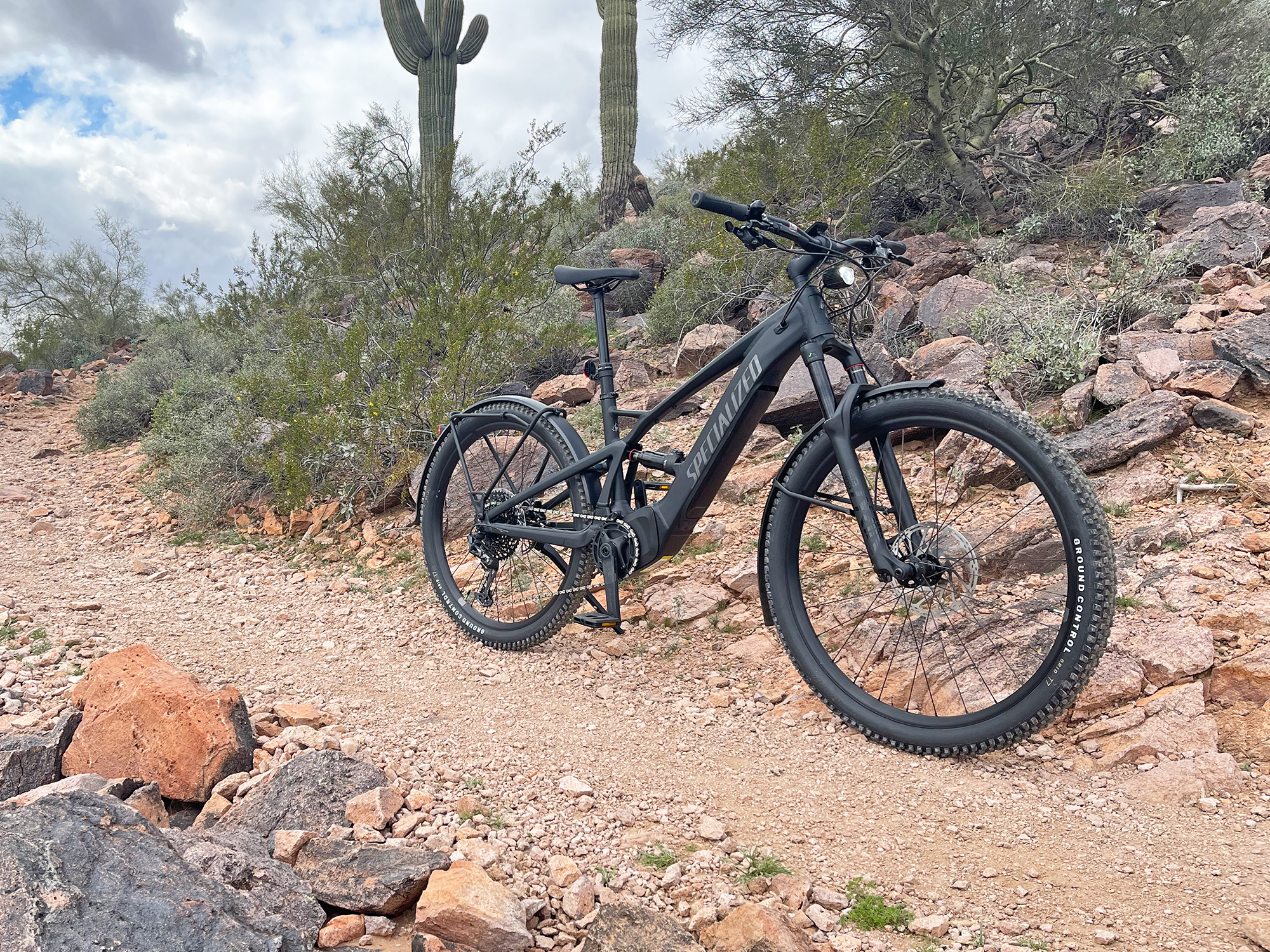
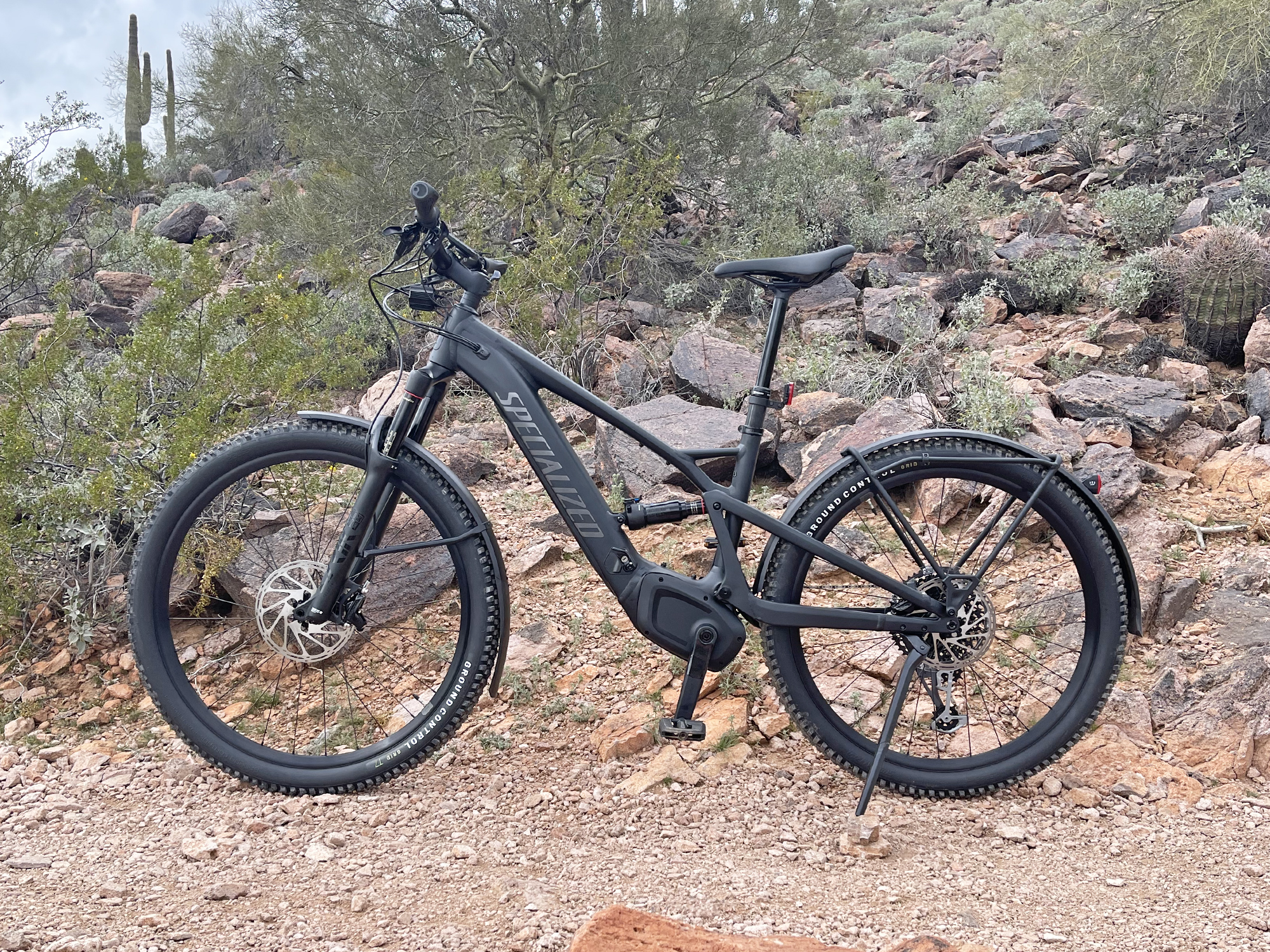
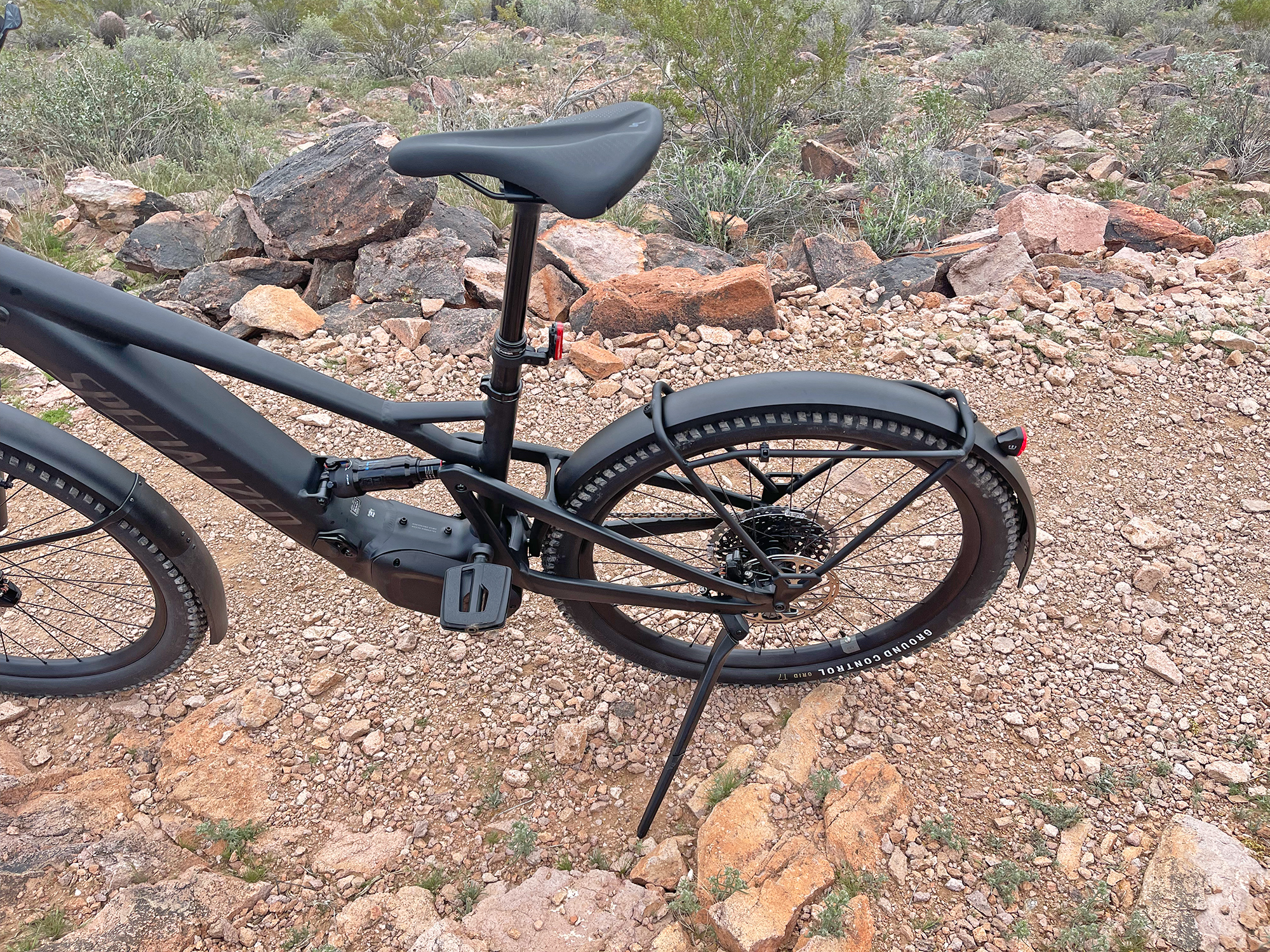
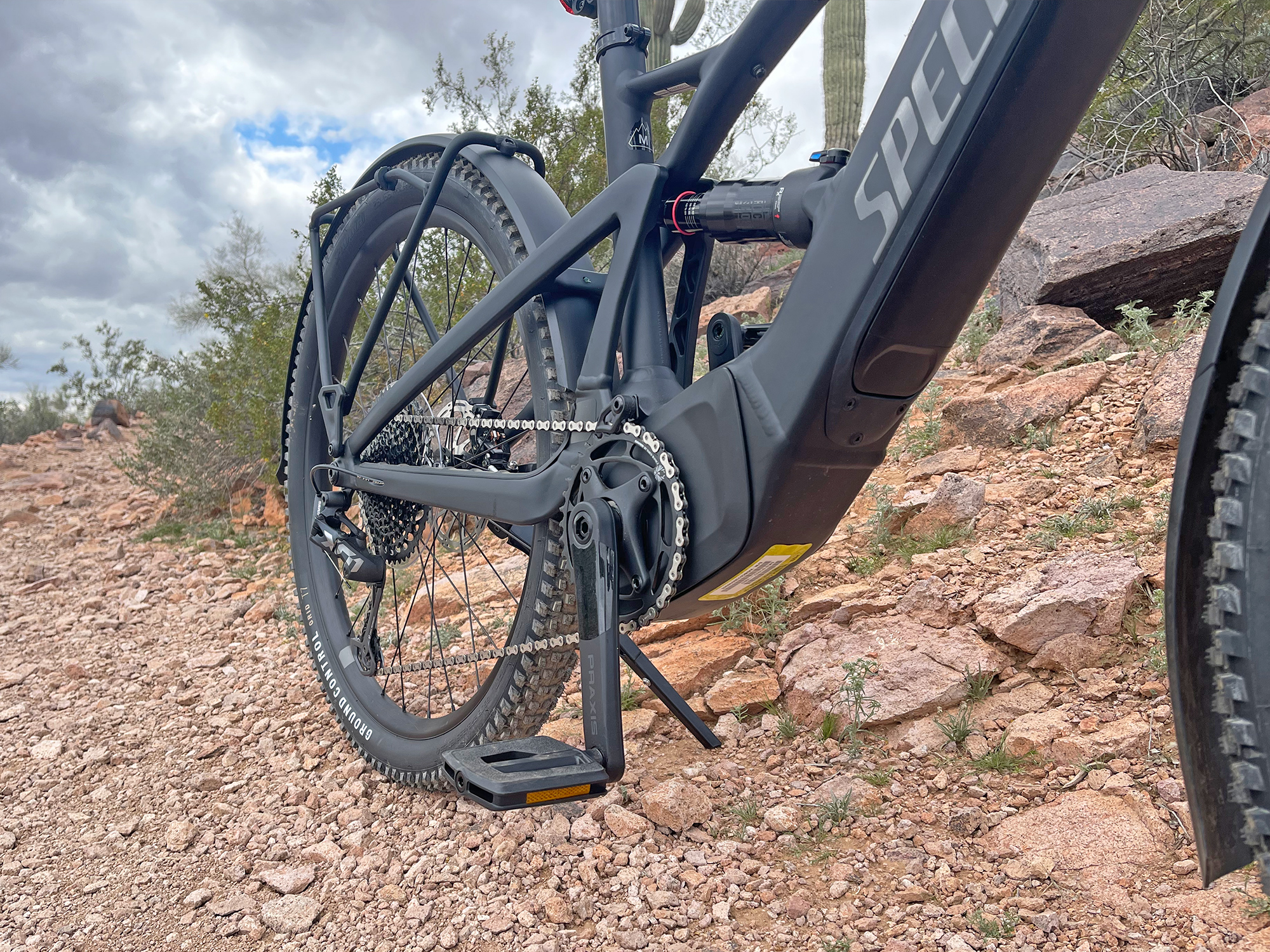
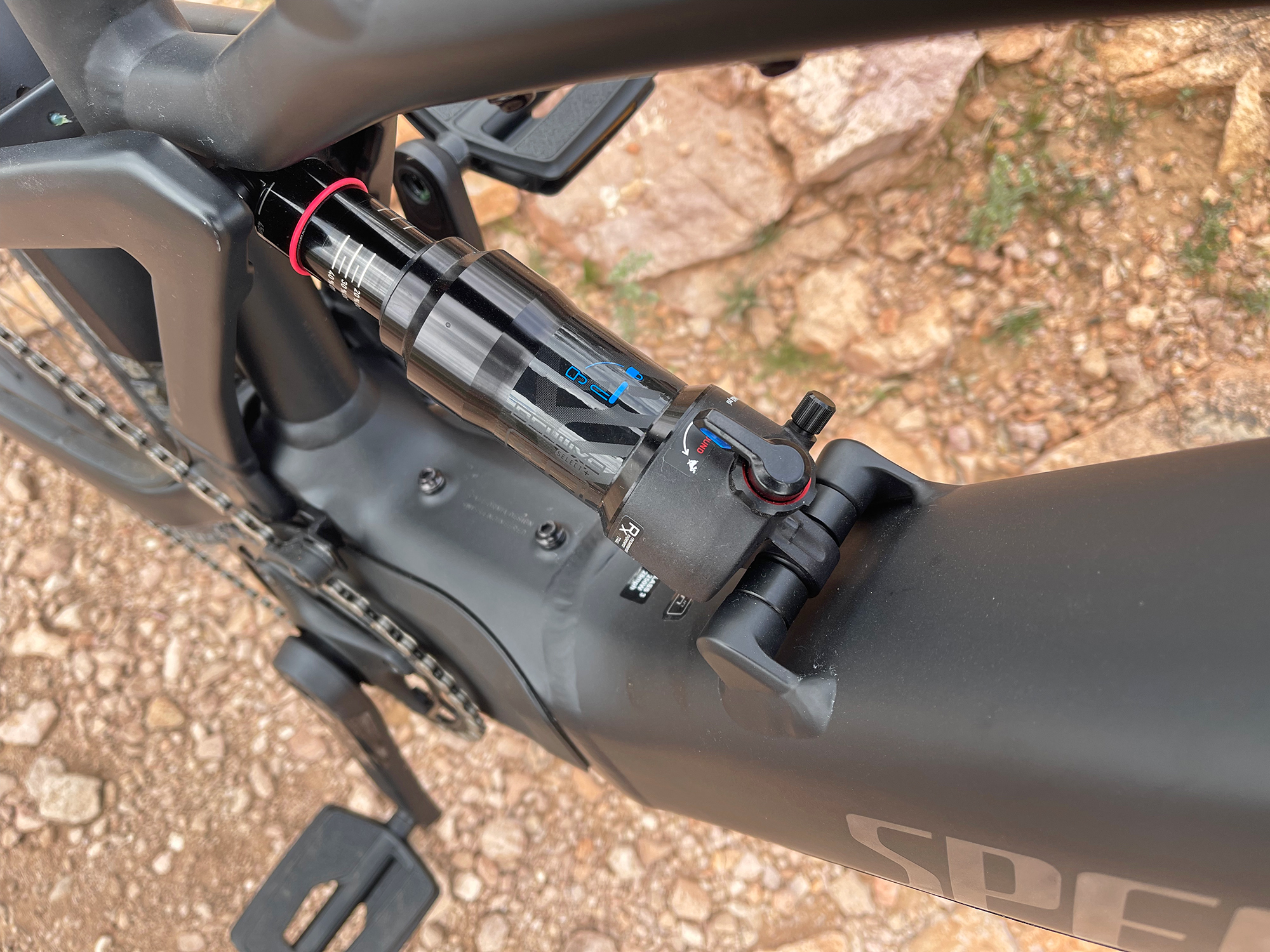
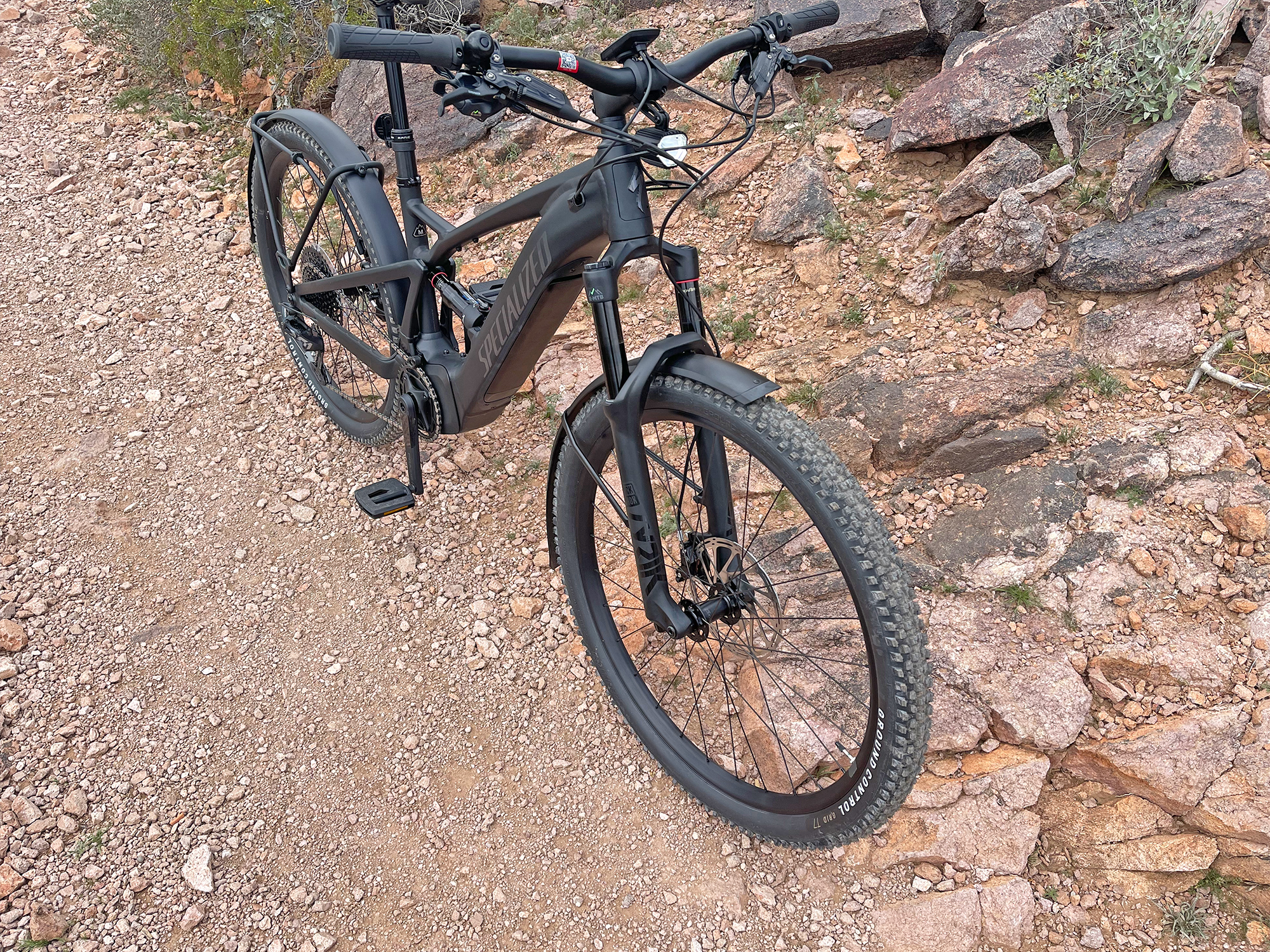

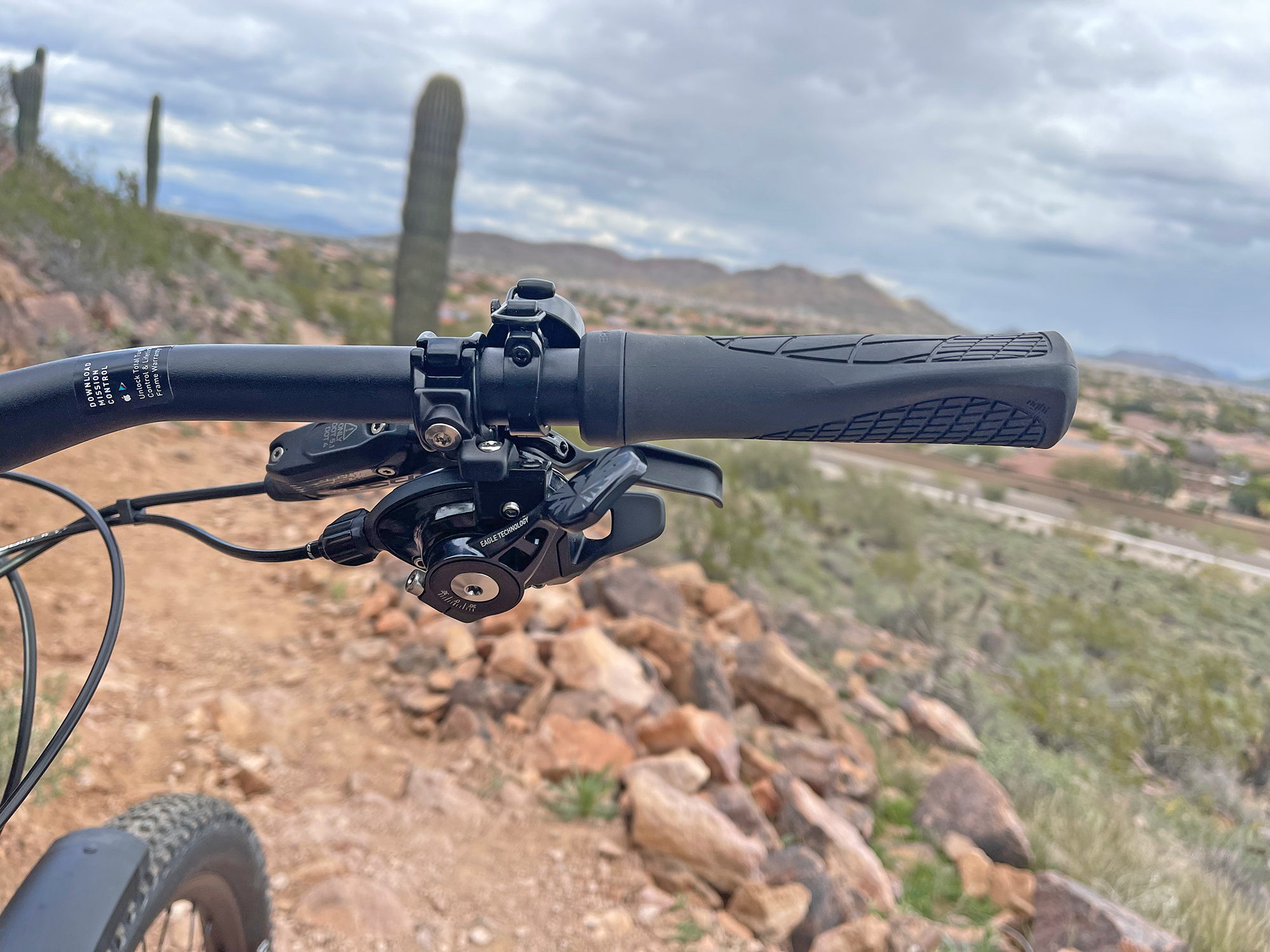
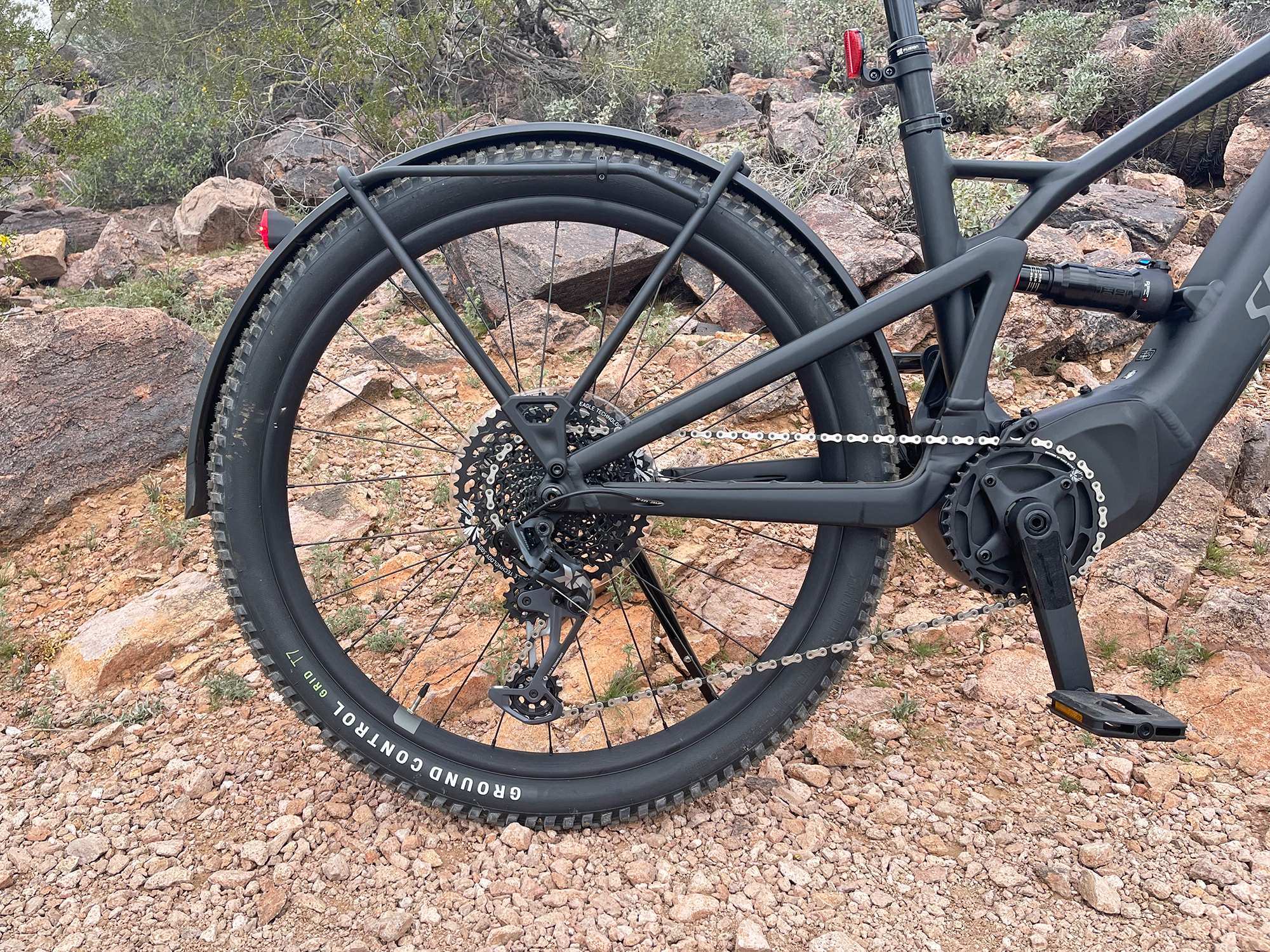
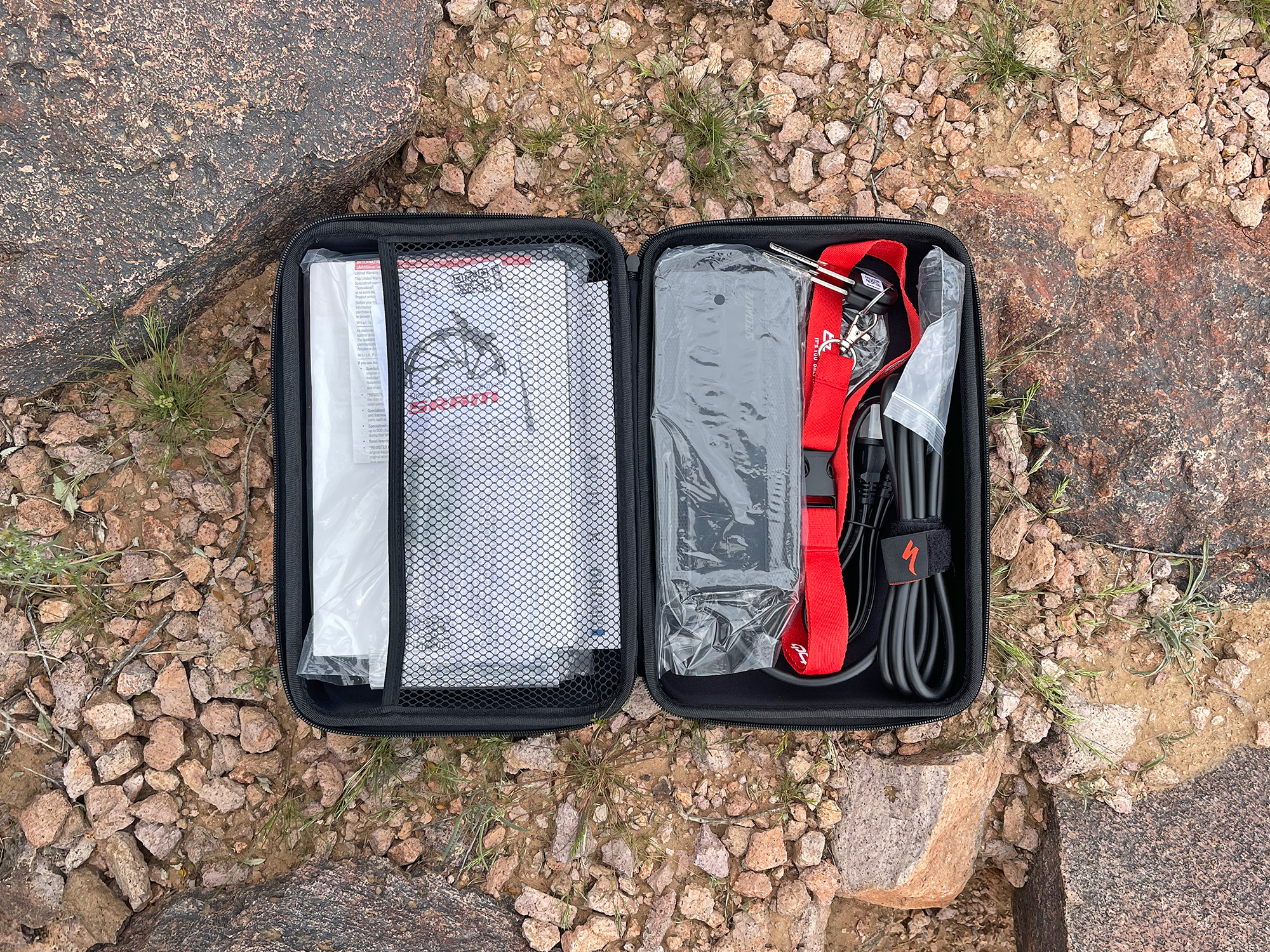
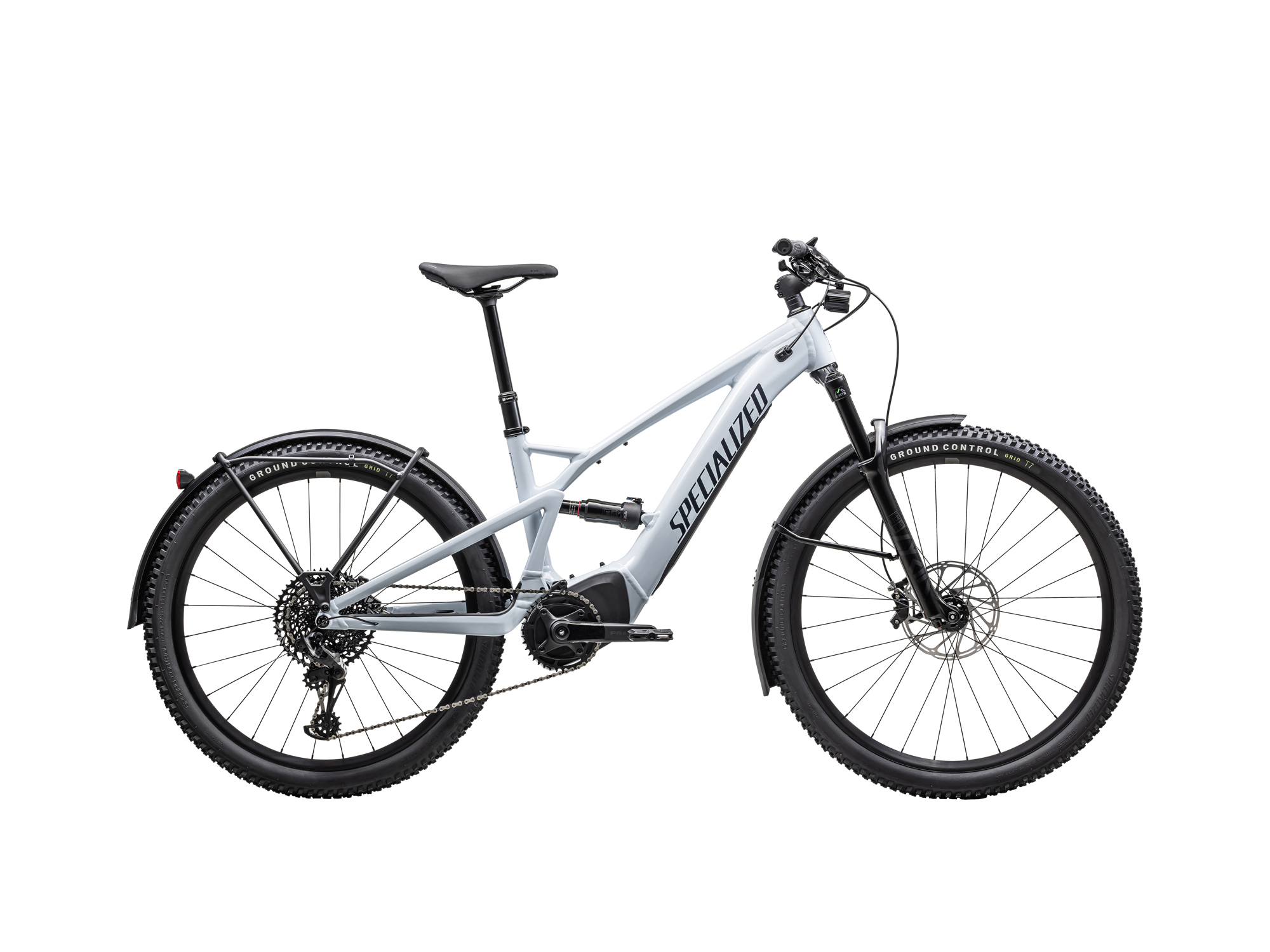
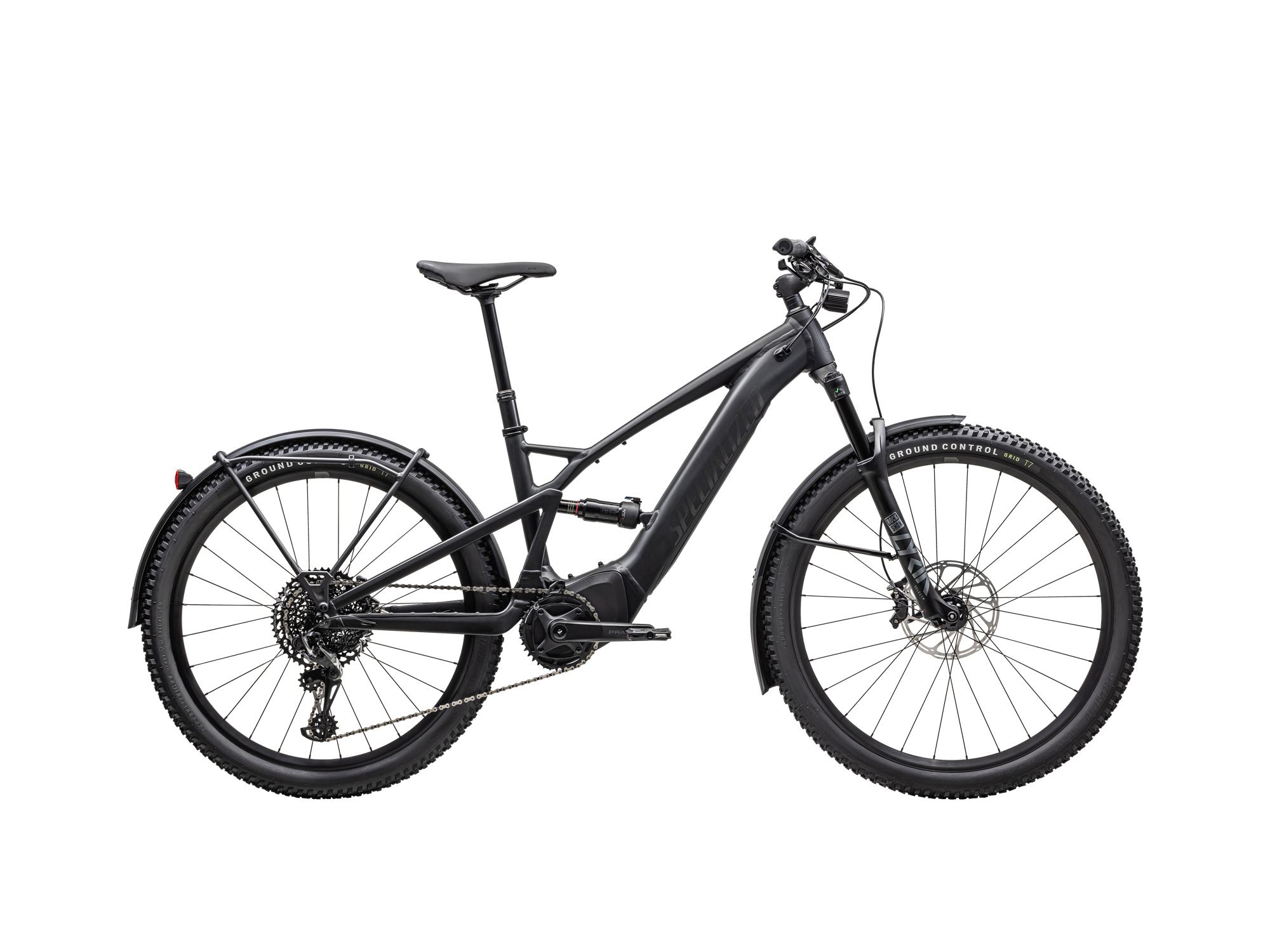

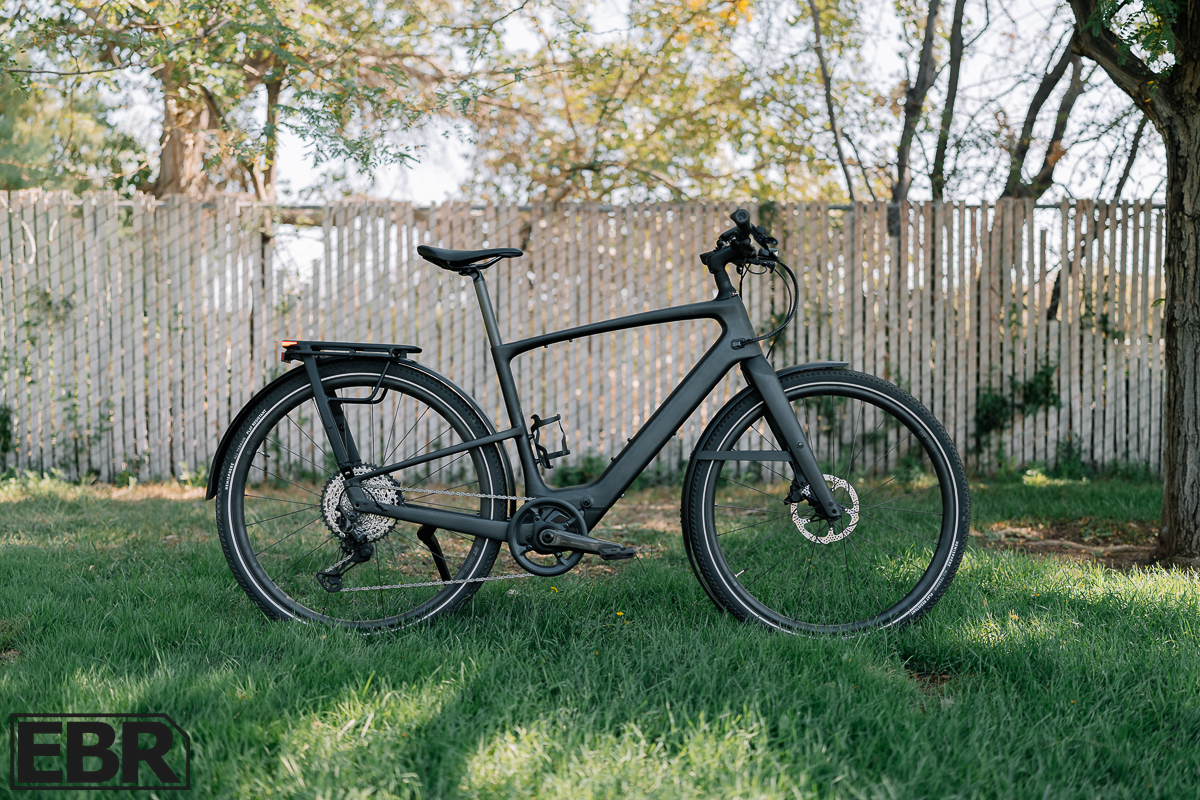
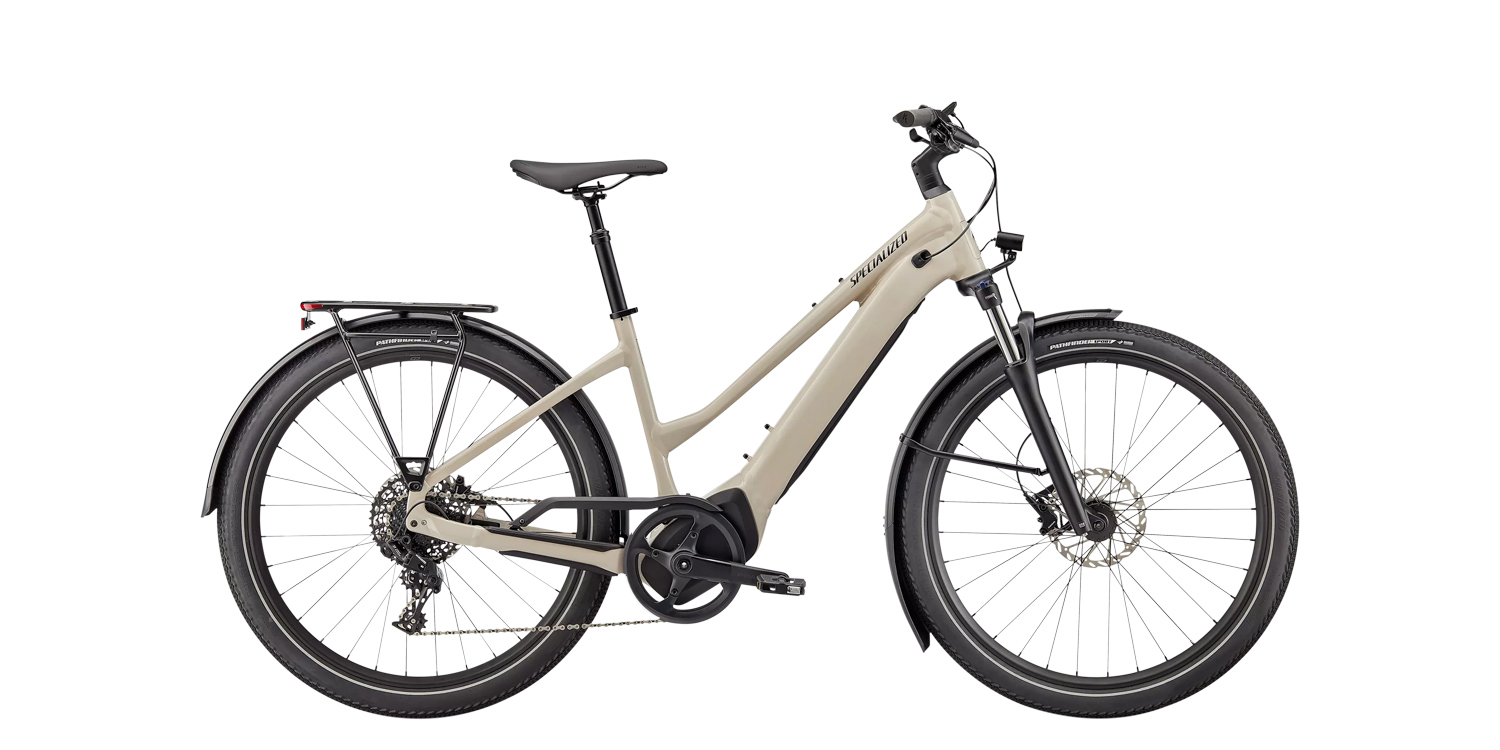
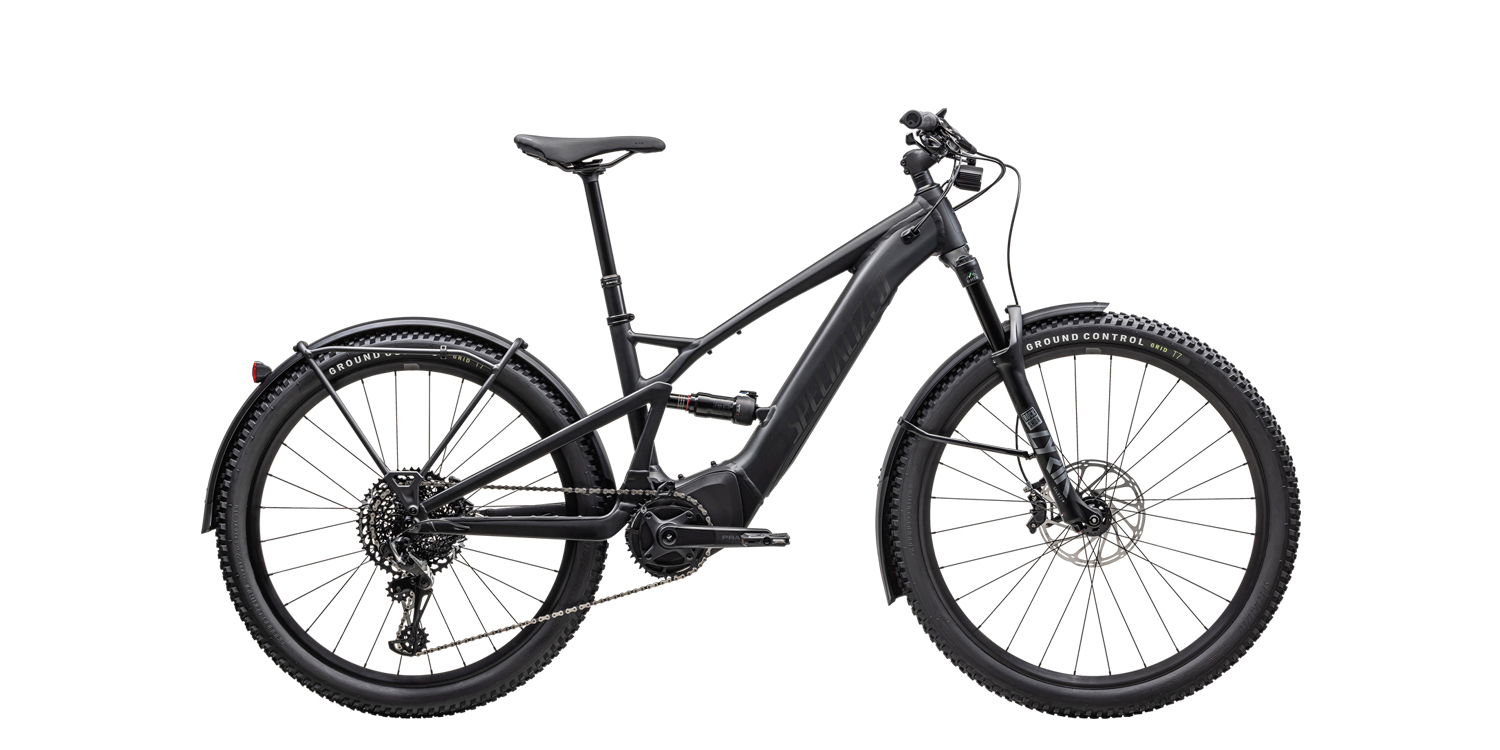
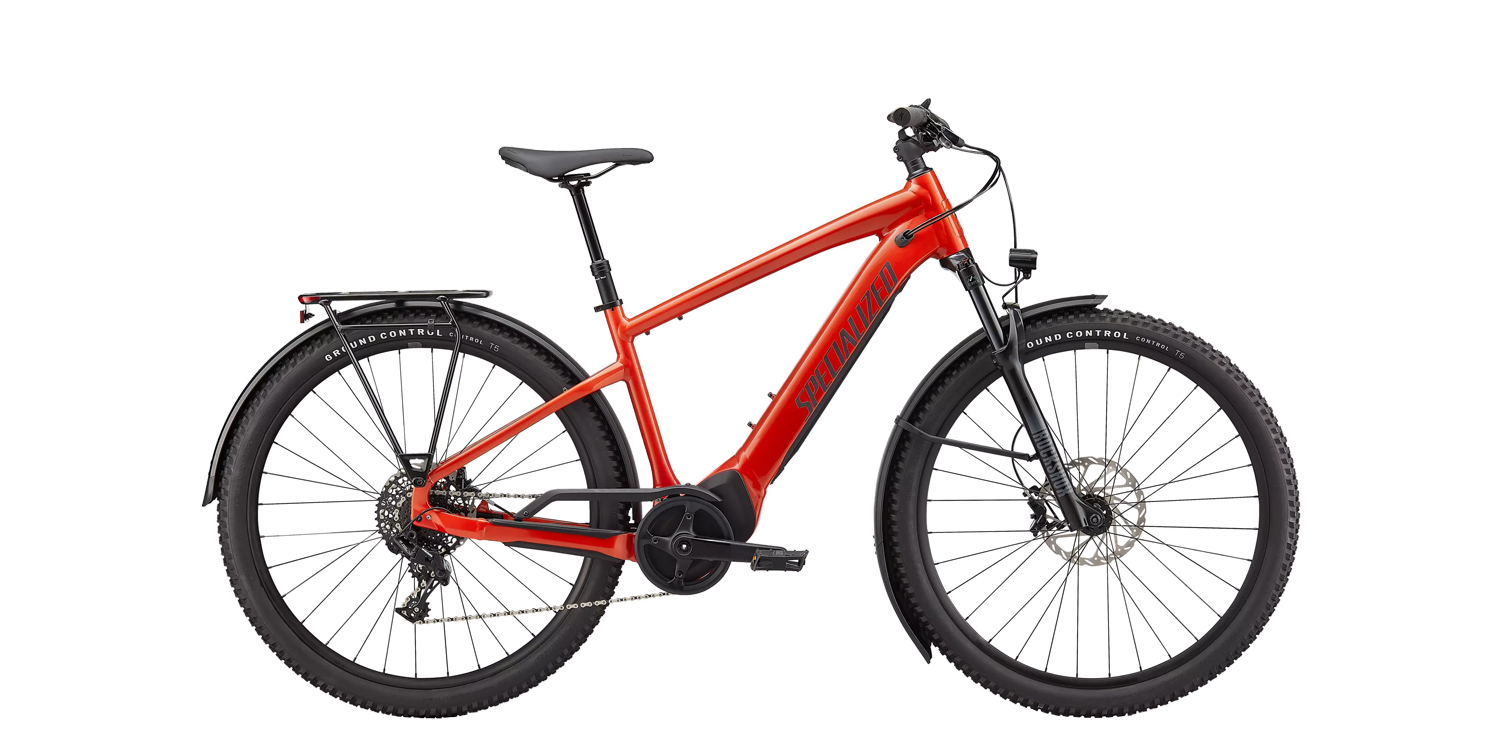
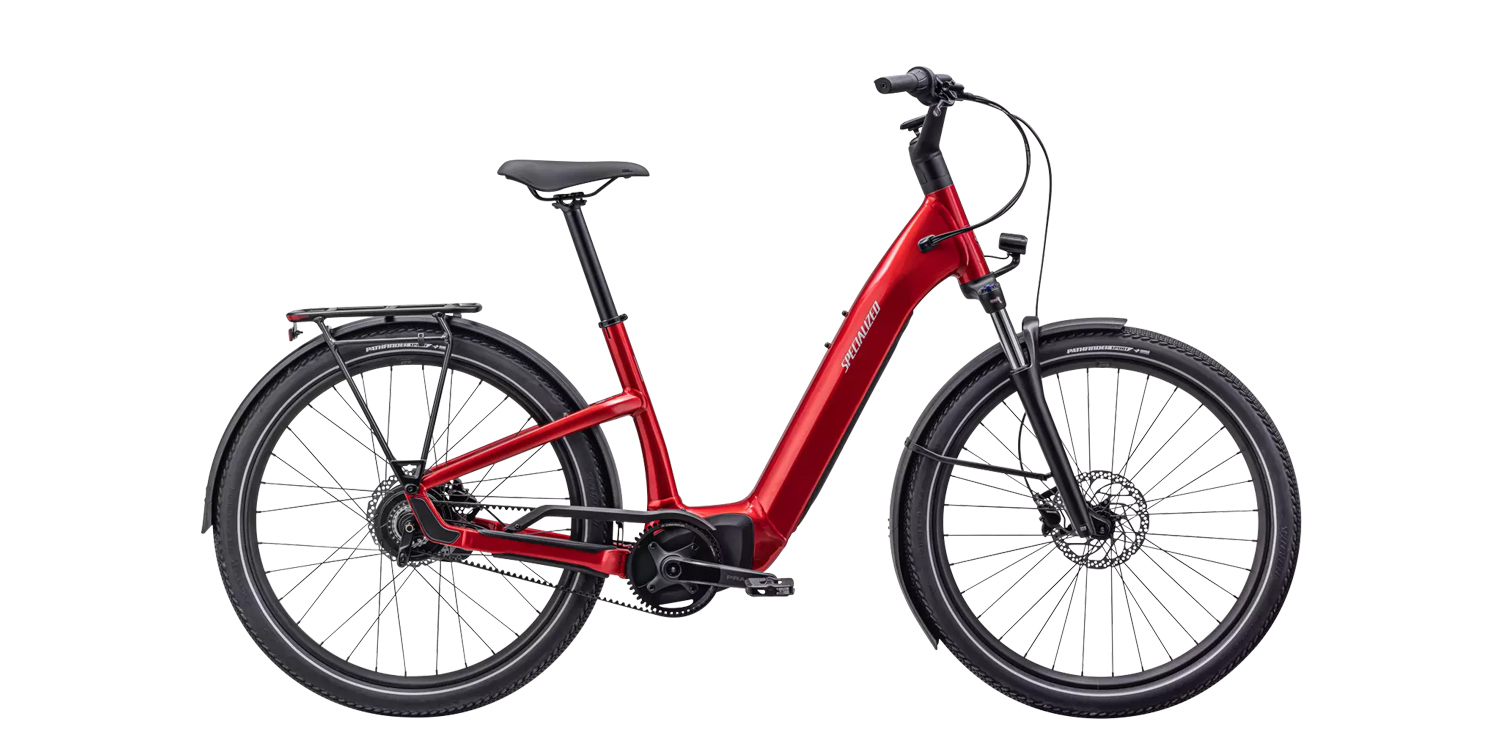
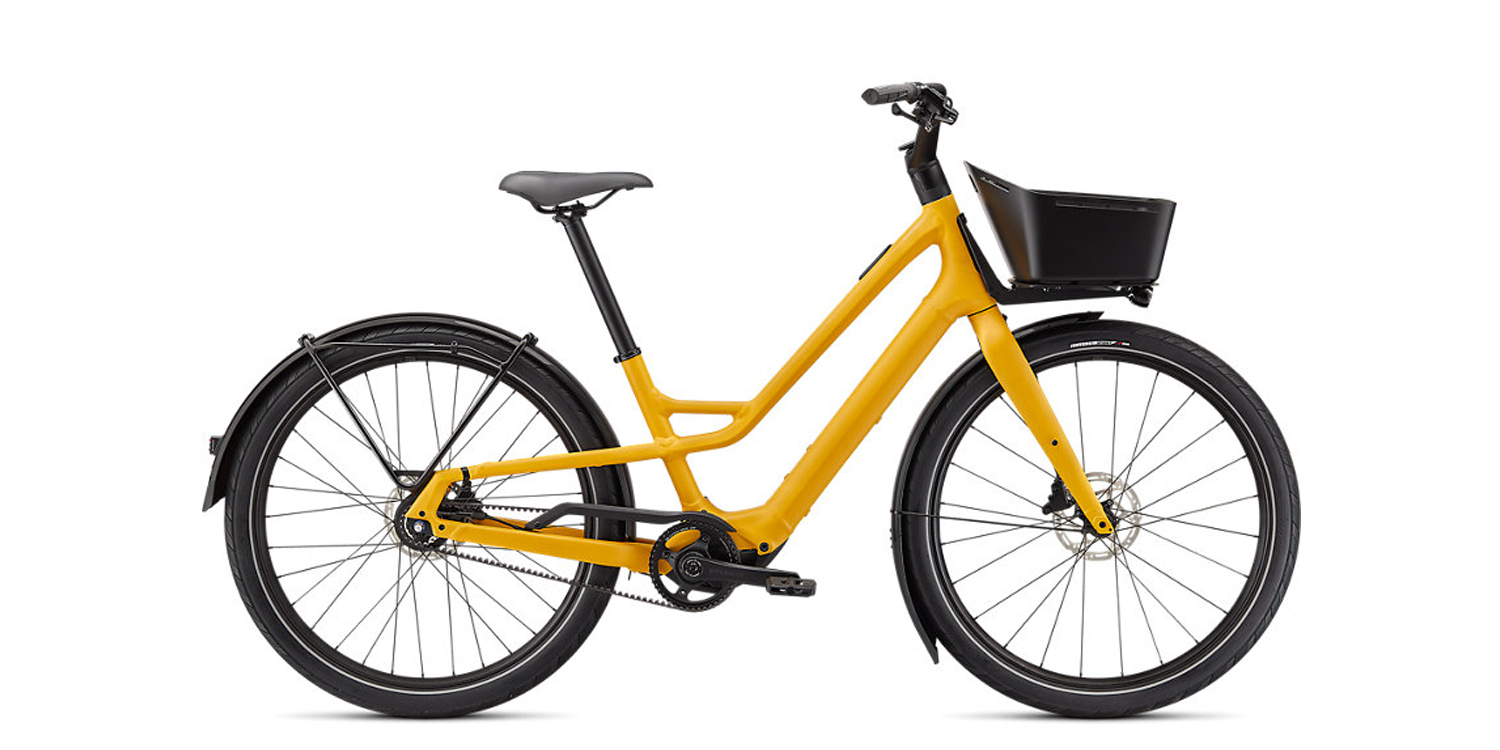
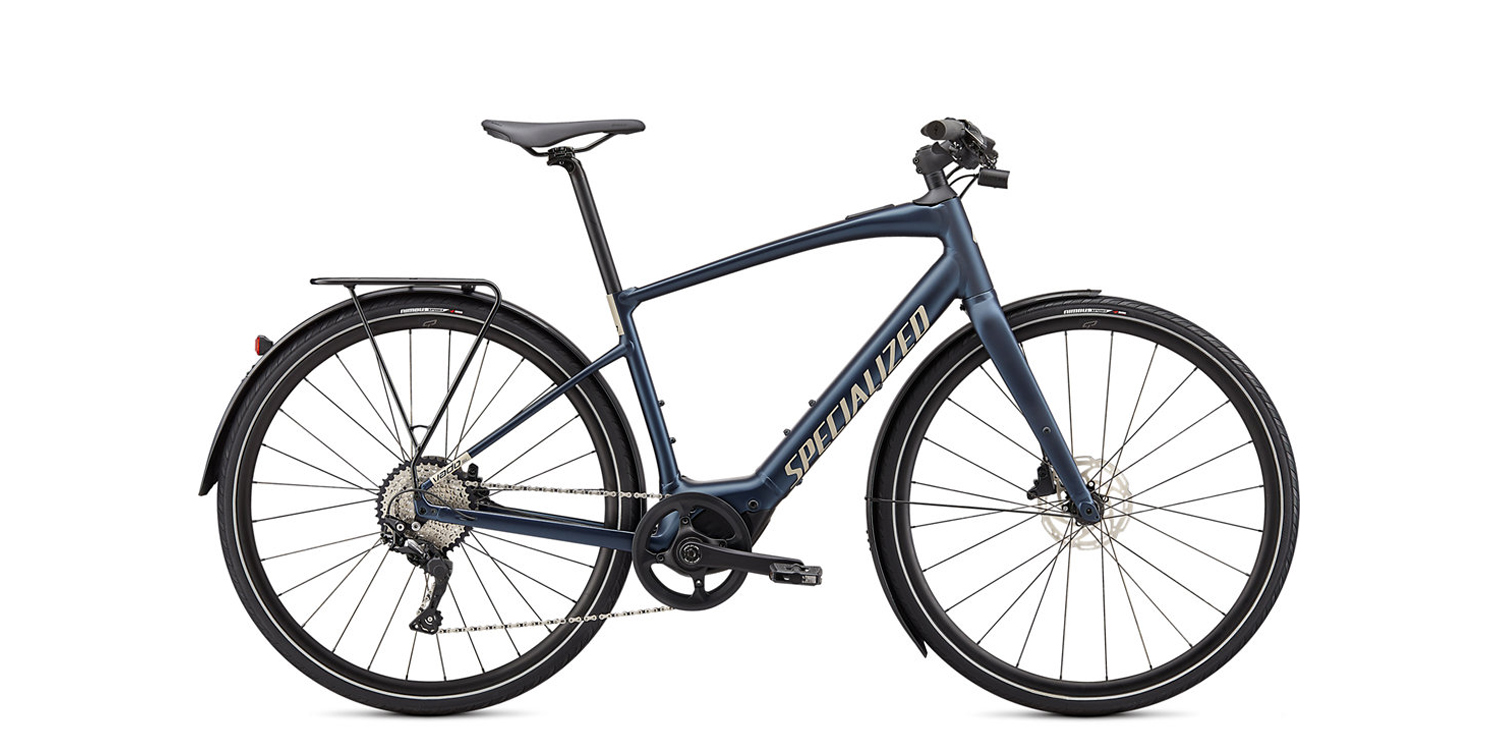
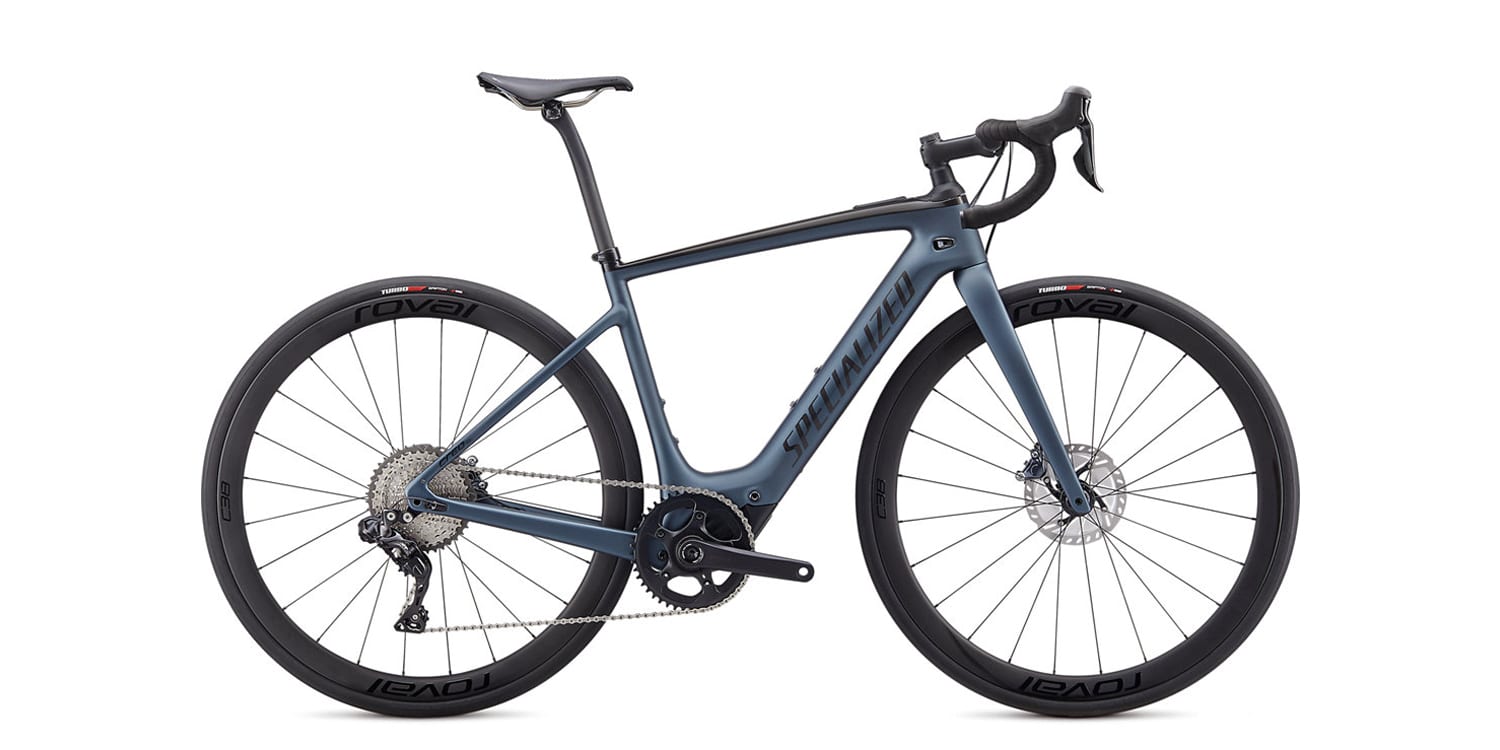
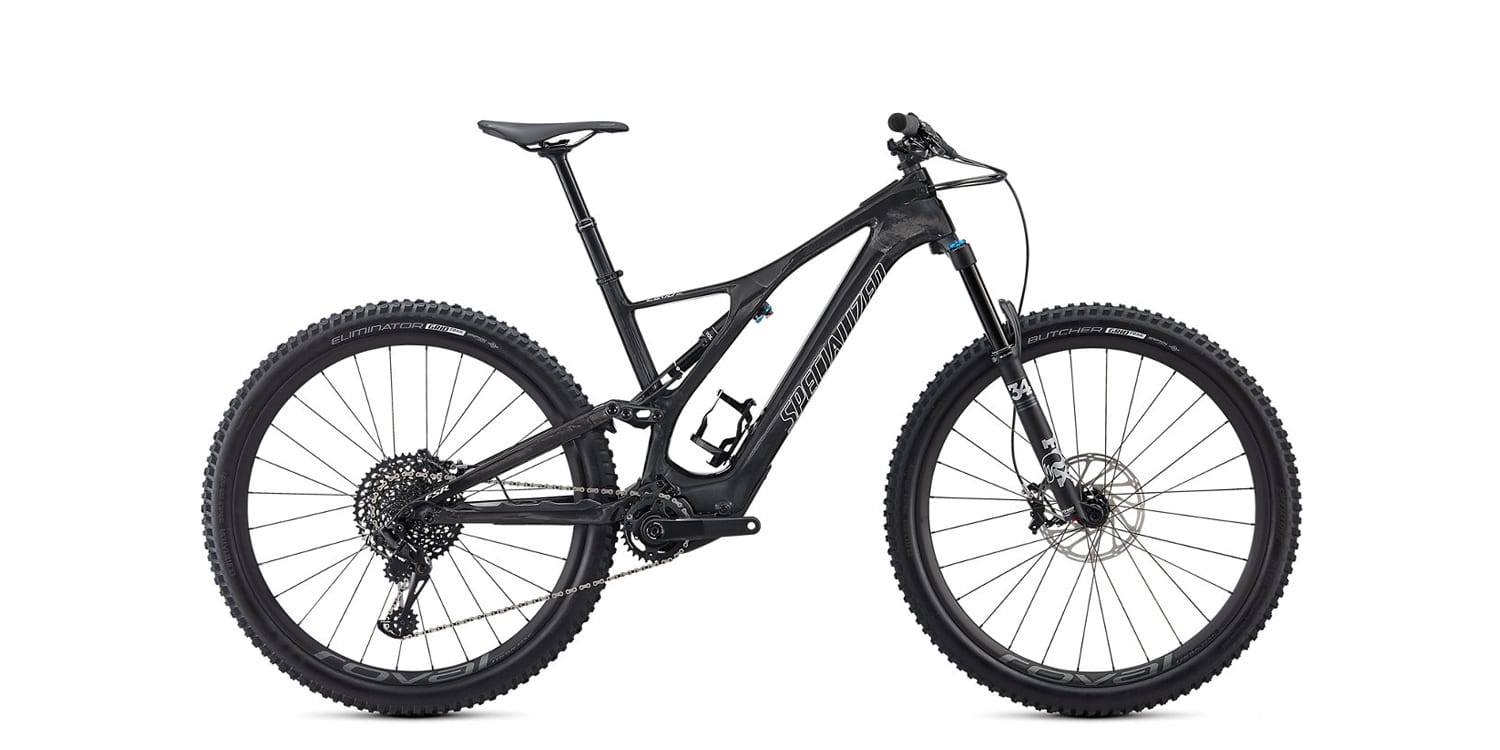
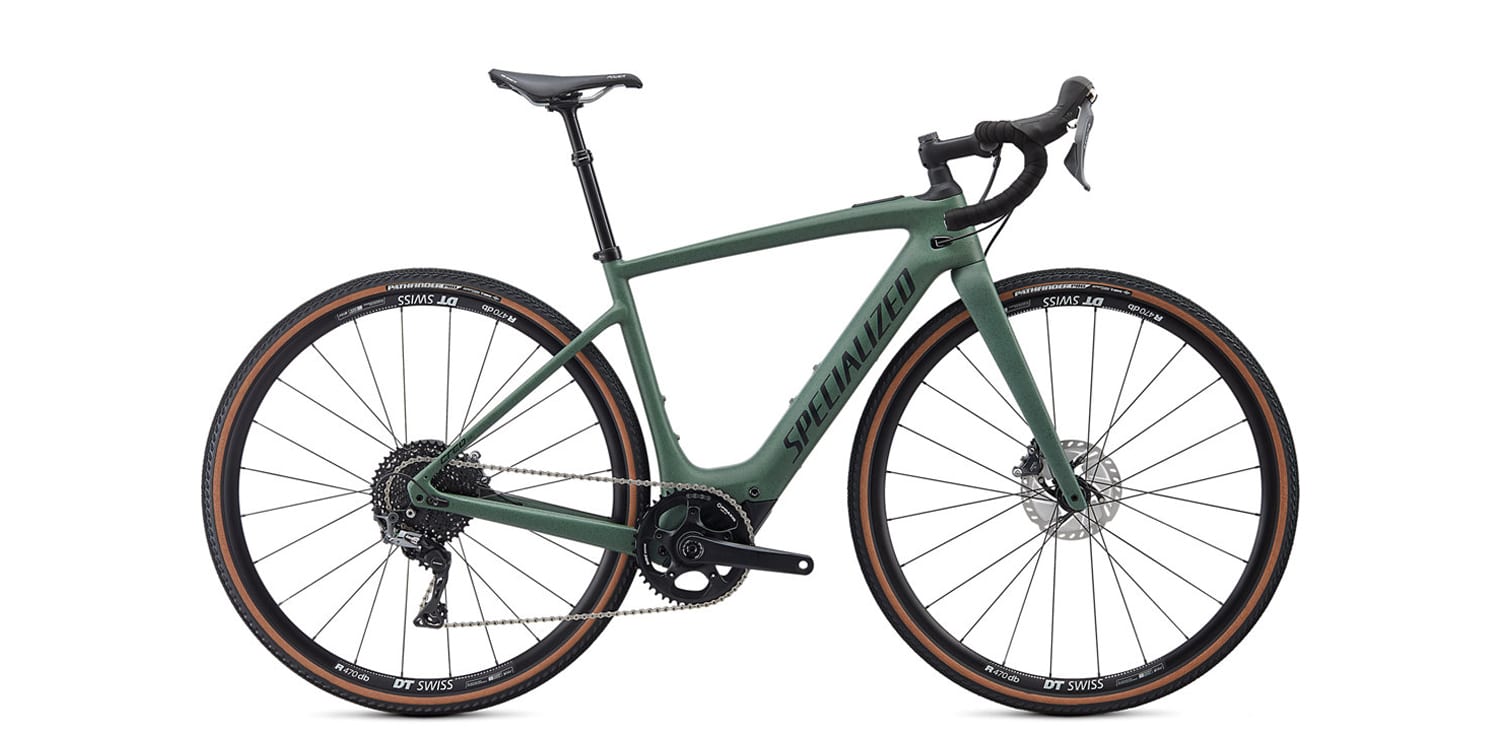
craig says
Hi Court,
Great review and nice bike. Is the battery unique to this model? Just wondering how available a rental battery might be when flying with the bike (since the battery would have to be shipped separately as dangerous goods).
Court says
Hi Craig, great question! I think this is the same battery pack used on the hardtail Turbo Tero, newer Vado, and Como models. Keep in mind, none of these are SL (super light) models, just the standard Vado and Como. It seems that Specialized has two sizes (530wh and 710wh) and I suspect they are both compatible. Although I do not know whether Specialized local dealers will loan or rent you a battery pack, there should be many around in different locales since so many models will be using them!
Jack says
Quietest motor ever, and BIG power on this one. I also have a Levo with this motor and you can barely hear it even on Turbo. In a low gear I’m pretty sure I could do a vertical ascent. ;-)
Court says
It’s awesome how powerful these things can be while still being quiet. Totally agree with your take here Jack. Do you have a Turbo Tero?
Jack says
I actually have a Levo with the same motor. I have the Creo SL too, but waiting for my new Trek with the TQ motor to get here :-) They should give you a commission on that one Court… LOL.
Court says
Sounds like an awesome stable of ebikes you’ve got there Jack! Great choices all around. I’m grateful that the companies lend me demo bikes and provide support about questions I have during the reviews. Trek and Specialized are two of the very best companies in the space right now, in my opinion ;) and I love the SL motor that Specialized developed with MAHLE!
Glen says
Hi Court, Having read and seen all of these reviews, I have a practical question. Given that these are expensive bikes, and you can’t afford to make a mistake, what would you choose of the following: Specialized Turbo Tero X 6.0, Trek Powerfly 9 or Trek Allante +7S?
Considerations are cost, comfort (two full and one front suspension), range (given the huge difference in battery sizes), weight. Like your thoughts if you had to chose one to live with for three years.
Thank you.
Regards, Glen
Court says
Hi Glen! Apologies for the slow reply, I’ve been working on site programming stuff and traveling recently. Long story short, I really like Trek’s dealers, consistency, and their Bosch drive systems… but they tend to weigh more than Specialized, not look quite as cool, and produce more noise. I really like the Specialized Turbo Tero models, and I ride a non-electric Specialized Stumpjumper, so their geometry and touch points are very familiar for me. I really like the new Turbo Tero X full suspension model because of the Class 3 faster speeds and comfort. that would be my choice, especially if there’s a dealer nearby, followed by the Powerfly 9. Hope this helps!
Glen says
Thanks for your feedback, Court. I think I agree on all points.
If I may, on a different note, if you were looking to buy a lightweight road bike, and was not a Mahle fan, would you prefer a Fazua (58Nm), TQ (50 Nm) or Specialized 1.1 motor 35Nm)? Would like your thoughts. I once owned a Specialized Turbo Creo EVO and sold it after moving to TN (Steep hills). After having since owned a Giant Revolt e (horrible ride) and now a Trek Domane +HP (very noisy and fees a bit disconnected, but like the 85 Nm), I am considering going back to a Specialized but the 35 Nm has me concerned.
Court says
Hi Glen, that’s a good question. I have not enjoyed the prior Fazua generations, and haven’t spent enough time with the latest ones to say. I’m not super familiar with TQ either… but I do actually like the MAHLE motors that Specialized is using on their SL ebikes. If that’s just not powerful enough, I think their Brose motors could work well. I’m also a fan of Shimano ebike motors, but they are just now entering with Class 3 and some of their power buttons, batteries, and charger plugs and dongles aren’t my favorite. Trade offs all around ;)
Greg says
Hi Court! I really appreciate your thorough, in-depth analysis of all the bikes that you review. I live in a semi-rural city in far northern California and am contemplating an e-SUV type bike. Although I plan to mainly use my bike for paved roads and paths, I do like the ability to go off road on dirt paths and gravel trails. But, I also plan for a long road trip perhaps down the Oregon coast. How does the Specialized Turbo Tero X 6.0 compare with the Riese and Muller Homage? I know you have ridden them both, but would you have a preference given my situation?
Thanks!
Court says
Hi Greg! That’s a great question, both are good bikes. I like some of the Bosch drive system features like shift detection, but prefer the off-road styling of Specialized frames… and really appreciate the reduced sound and weight on the Tero X. It’s nearly 14 pounds lighter than the last Homage that I covered (58.7lbs vs. 73.6lbs). I also appreciate the Class 3 performance of both the Tero and Homage models, though some Homage are sold as Class 1 as well. I think the Homage fits into an urban environment nicely, while the Tero has some trail and mountain capabilities based on the tires. Hope this helps!!
George says
I appreciate the great review. Do you have a sense of where the boundaries of the Tero X off road capabilities lie and where one would benefit from a Levo? My LBS is advising against the Tero X if I intend to do much single track riding, and I am not sure how much of that is valid vs a lack of familiarity with the new product, for mild to moderate single track.
How is the feel of the riding position on the Tero X compared to the Levo? Would the Tero X be much more upright and comfortable for pavement cruising / mixed use or is the positioning similarly low and forward?
Court says
Hi George, I think you’re on the right track. I do think the Tero X is more upright, it has the Class 3 performance that may not be legal on some mountain trails, and the rear suspension is probably not as dynamic and responsive as the four-bar horst-link used on the Levo. You also have the heavier fenders and rear rack, adding to the unsprung weight. The rear light is unsprung, but the headlight is sprung! I like all of these features and wouldn’t shy away from the Tero X for light trail and cross country, but it is not as trail optimized… Hope this helps you, and sorry for the slow reply ;)
Adam Kimball says
First, thanks for your awesome work. I’ve watched the videos for the two Turbo Tero’s at least 5 times each and STILL learn a few things, thank you!
I’m trying to decide between an X 6.0 and a hardtail 5.0. My ideal bike is probably and R&M Delite. I’m looking for something I can really explore with, not bombing downhill (I have an Epic Evo for that) but definitely off the beaten path. However, I like to fish and photograph and want to bring gear with me. I worry the non-X Tero might not be up to the task – maybe it is more commuter focused? Is there any reason why this bike couldn’t manage some singletrack, jeep roads, and mountain work within reasonable limits?
Any thoughts?
Thanks!
Adam
Court says
Hi Adam! Thanks for the compliments, and sorry for the slow reply here. I’ve been out looking at other bikes! The Tero models are both excellent, in my opinion. I would happily take the hardtail on cross country and light trail and feel confident in its strength and performance, but the comfort would definitely be diminished. Due to my sensitive back and knees, a rear suspension really makes a difference, but if you’re less sensitive… then it’s probably fine riding the less expensive hardtail. You could always add a suspension seatpost or dropper + suspension post from Limoteq (like some BULLS models use). I would personally pay more for the Tero X, but note that the rear rack is not unsprung like the R&M Delite. That bike is amazing! but way heavier. Another difference is that the Riese & Muller is going to be Class 1 probably, while the Tero is Class 3. I love the higher speed, but some trails might not allow it… technically. Hope this guidance helps you, and have a blast, whatever you choose!